
List of Central American mammals
Encyclopedia
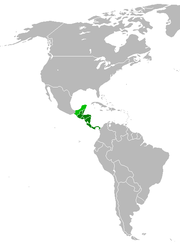
Central America
Central America is the central geographic region of the Americas. It is the southernmost, isthmian portion of the North American continent, which connects with South America on the southeast. When considered part of the unified continental model, it is considered a subcontinent...
is usually defined as the southernmost extension of North America
North America
North America is a continent wholly within the Northern Hemisphere and almost wholly within the Western Hemisphere. It is also considered a northern subcontinent of the Americas...
; however, from a biological standpoint it is useful to view it as a separate region of the Americas
Americas
The Americas, or America , are lands in the Western hemisphere, also known as the New World. In English, the plural form the Americas is often used to refer to the landmasses of North America and South America with their associated islands and regions, while the singular form America is primarily...
. Central America is distinct from the remainder of North America in being a tropical
Tropics
The tropics is a region of the Earth surrounding the Equator. It is limited in latitude by the Tropic of Cancer in the northern hemisphere at approximately N and the Tropic of Capricorn in the southern hemisphere at S; these latitudes correspond to the axial tilt of the Earth...
region, part of the Neotropic ecozone, whose flora and fauna display a strong South America
South America
South America is a continent situated in the Western Hemisphere, mostly in the Southern Hemisphere, with a relatively small portion in the Northern Hemisphere. The continent is also considered a subcontinent of the Americas. It is bordered on the west by the Pacific Ocean and on the north and east...
n influence. The rest of North America is mostly subtropical or temperate, belongs to the Nearctic ecozone, and has many fewer species of South American origin.
At present Central America bridges North and South America, facilitating migrations in both directions, but this phenomenon is relatively recent from a geological perspective. The formation of this land bridge through volcanic activity three million years ago precipitated the Great American Interchange
Great American Interchange
The Great American Interchange was an important paleozoogeographic event in which land and freshwater fauna migrated from North America via Central America to South America and vice versa, as the volcanic Isthmus of Panama rose up from the sea floor and bridged the formerly separated continents...
, an important biogeographical
Biogeography
Biogeography is the study of the distribution of species , organisms, and ecosystems in space and through geological time. Organisms and biological communities vary in a highly regular fashion along geographic gradients of latitude, elevation, isolation and habitat area...
event. In part because of this history, Central America is extremely biodiverse
Biodiversity
Biodiversity is the degree of variation of life forms within a given ecosystem, biome, or an entire planet. Biodiversity is a measure of the health of ecosystems. Biodiversity is in part a function of climate. In terrestrial habitats, tropical regions are typically rich whereas polar regions...
; it comprises most of the Mesoamerican biodiversity hotspot
Biodiversity hotspot
A biodiversity hotspot is a biogeographic region with a significant reservoir of biodiversity that is under threat from humans.The concept of biodiversity hotspots was originated by Norman Myers in two articles in “The Environmentalist” , revised after thorough analysis by Myers and others in...
. The mountains running down the spine of Central America have also contributed to biodiversity by creating montane
Montane
In biogeography, montane is the highland area located below the subalpine zone. Montane regions generally have cooler temperatures and often have higher rainfall than the adjacent lowland regions, and are frequently home to distinct communities of plants and animals.The term "montane" means "of the...
habitats, including cloud forest
Cloud forest
A cloud forest, also called a fog forest, is a generally tropical or subtropical evergreen montane moist forest characterized by a persistent, frequent or seasonal low-level cloud cover, usually at the canopy level. Cloud forests often exhibit an abundance of mosses covering the ground and...
s and grasslands
Costa Rican páramo
The Costa Rican páramo, also known as the Talamanca páramo, is a montane grassland and shrubland of Costa Rica and western Panama.-Setting:...
, and by separating species from the lowland
Lowland
In physical geography, a lowland is any broad expanse of land with a general low level. The term is thus applied to the landward portion of the upward slope from oceanic depths to continental highlands, to a region of depression in the interior of a mountainous region, to a plain of denudation, or...
s along the Pacific
Pacific Ocean
The Pacific Ocean is the largest of the Earth's oceanic divisions. It extends from the Arctic in the north to the Southern Ocean in the south, bounded by Asia and Australia in the west, and the Americas in the east.At 165.2 million square kilometres in area, this largest division of the World...
and Caribbean
Caribbean Sea
The Caribbean Sea is a sea of the Atlantic Ocean located in the tropics of the Western hemisphere. It is bounded by Mexico and Central America to the west and southwest, to the north by the Greater Antilles, and to the east by the Lesser Antilles....
coasts. However, Central America's biodiversity suffered a blow in the Quaternary extinction event
Quaternary extinction event
The Quaternary period saw the extinctions of numerous predominantly larger, especially megafaunal, species, many of which occurred during the transition from the Pleistocene to the Holocene epoch. However, the extinction wave did not stop at the end of the Pleistocene, but continued especially on...
, which started around 12500 cal BP, at roughly the time of arrival of Paleoindians; much of the megafauna
Pleistocene megafauna
Pleistocene megafauna is the set of species of large animals — mammals, birds and reptiles — that lived on Earth during the Pleistocene epoch and became extinct in a Quaternary extinction event. These species appear to have died off as humans expanded out of Africa and southern Asia,...
died out at this time. The effects of modern human activities on climate
Global warming
Global warming refers to the rising average temperature of Earth's atmosphere and oceans and its projected continuation. In the last 100 years, Earth's average surface temperature increased by about with about two thirds of the increase occurring over just the last three decades...
and ecosystem
Ecosystem
An ecosystem is a biological environment consisting of all the organisms living in a particular area, as well as all the nonliving , physical components of the environment with which the organisms interact, such as air, soil, water and sunlight....
integrity pose a further threat to Central America's fauna
Fauna
Fauna or faunæ is all of the animal life of any particular region or time. The corresponding term for plants is flora.Zoologists and paleontologists use fauna to refer to a typical collection of animals found in a specific time or place, e.g. the "Sonoran Desert fauna" or the "Burgess shale fauna"...
.
The list consists of those mammal
Mammal
Mammals are members of a class of air-breathing vertebrate animals characterised by the possession of endothermy, hair, three middle ear bones, and mammary glands functional in mothers with young...
species found from the Isthmus of Tehuantepec
Isthmus of Tehuantepec
The Isthmus of Tehuantepec is an isthmus in Mexico. It represents the shortest distance between the Gulf of Mexico and the Pacific Ocean, and prior to the opening of the Panama Canal was a major shipping route known simply as the Tehuantepec Route...
to the northwestern border of Colombia
Colombia
Colombia, officially the Republic of Colombia , is a unitary constitutional republic comprising thirty-two departments. The country is located in northwestern South America, bordered to the east by Venezuela and Brazil; to the south by Ecuador and Peru; to the north by the Caribbean Sea; to the...
, a region including the Mexican states of Chiapas
Chiapas
Chiapas officially Estado Libre y Soberano de Chiapas is one of the 31 states that, with the Federal District, comprise the 32 Federal Entities of Mexico. It is divided in 118 municipalities and its capital city is Tuxtla Gutierrez. Other important cites in Chiapas include San Cristóbal de las...
, Tabasco
Tabasco
Tabasco officially Estado Libre y Soberano de Tabasco is one of the 31 states which, with the Federal District, comprise the 32 Federal Entities of Mexico. It is divided in 17 municipalities and its capital city is Villahermosa....
, Campeche
Campeche
Campeche is one of the 31 states which, with the Federal District, comprise the 32 Federal Entities of Mexico. Located in Southeast Mexico, it is bordered by the states of Yucatán to the north east, Quintana Roo to the east, and Tabasco to the south west...
, Yucatán
Yucatán
Yucatán officially Estado Libre y Soberano de Yucatán is one of the 31 states which, with the Federal District, comprise the 32 Federal Entities of Mexico. It is divided in 106 municipalities and its capital city is Mérida....
and Quintana Roo
Quintana Roo
Quintana Roo officially Estado Libre y Soberano de Quintana Roo is one of the 31 states which, with the Federal District, comprise the 32 Federal Entities of Mexico. It is divided in 10 municipalities and its capital city is Chetumal....
, and the nations of Belize
Belize
Belize is a constitutional monarchy and the northernmost country in Central America. Belize has a diverse society, comprising many cultures and languages. Even though Kriol and Spanish are spoken among the population, Belize is the only country in Central America where English is the official...
, Guatemala
Guatemala
Guatemala is a country in Central America bordered by Mexico to the north and west, the Pacific Ocean to the southwest, Belize to the northeast, the Caribbean to the east, and Honduras and El Salvador to the southeast...
, El Salvador
El Salvador
El Salvador or simply Salvador is the smallest and the most densely populated country in Central America. The country's capital city and largest city is San Salvador; Santa Ana and San Miguel are also important cultural and commercial centers in the country and in all of Central America...
, Honduras
Honduras
Honduras is a republic in Central America. It was previously known as Spanish Honduras to differentiate it from British Honduras, which became the modern-day state of Belize...
, Nicaragua
Nicaragua
Nicaragua is the largest country in the Central American American isthmus, bordered by Honduras to the north and Costa Rica to the south. The country is situated between 11 and 14 degrees north of the Equator in the Northern Hemisphere, which places it entirely within the tropics. The Pacific Ocean...
, Costa Rica
Costa Rica
Costa Rica , officially the Republic of Costa Rica is a multilingual, multiethnic and multicultural country in Central America, bordered by Nicaragua to the north, Panama to the southeast, the Pacific Ocean to the west and the Caribbean Sea to the east....
and Panama
Panama
Panama , officially the Republic of Panama , is the southernmost country of Central America. Situated on the isthmus connecting North and South America, it is bordered by Costa Rica to the northwest, Colombia to the southeast, the Caribbean Sea to the north and the Pacific Ocean to the south. The...
. As of 4 March 2009, the list had 359 entries. Of these species, 1 is critically endangered or extinct
Extinction
In biology and ecology, extinction is the end of an organism or of a group of organisms , normally a species. The moment of extinction is generally considered to be the death of the last individual of the species, although the capacity to breed and recover may have been lost before this point...
, 11 are critically endangered
Critically endangered
Version 2010.3 of the IUCN Red List of Threatened Species identified 3744 Critically Endangered species, subspecies and varieties, stocks and subpopulations.Critically Endangered by kingdom:*1993 Animalia*2 Fungi*1745 Plantae*4 Protista-References:...
, 12 are endangered
Endangered species
An endangered species is a population of organisms which is at risk of becoming extinct because it is either few in numbers, or threatened by changing environmental or predation parameters...
, 17.5 are vulnerable
Vulnerable species
On 30 January 2010, the IUCN Red List of Threatened Species identified 9694 Vulnerable species, subspecies and varieties, stocks and sub-populations.-References:...
, 20 are near-threatened
Near Threatened
Near Threatened is a conservation status assigned to species or lower taxa that may be considered threatened with extinction in the near future, although it does not currently qualify for the threatened status...
, and 33.5 are data-deficient
Data Deficient
Data Deficient is a category applied by the IUCN, other agencies, and individuals to a species when the available information is not sufficient for a proper assessment of conservation status to be made...
. Mammal species presumed extinct since AD 1500 (two cases) are included. Introduced species
Introduced species
An introduced species — or neozoon, alien, exotic, non-indigenous, or non-native species, or simply an introduction, is a species living outside its indigenous or native distributional range, and has arrived in an ecosystem or plant community by human activity, either deliberate or accidental...
are not listed.
NOTE: this list is almost inevitably going to be incomplete, since new species are continually being recognized via discovery or reclassification. Places to check for missing species include the Wikipedia missing mammal species list, including recently removed entries, and the species listings in the articles for mammalian genera, especially those of small mammals such as rodents or bats.
The following tags are used to highlight each species' conservation status as assessed by the IUCN
World Conservation Union
The International Union for Conservation of Nature and Natural Resources is an international organization dedicated to finding "pragmatic solutions to our most pressing environment and development challenges." The organization publishes the IUCN Red List, compiling information from a network of...
:
| EX | Extinct Extinction In biology and ecology, extinction is the end of an organism or of a group of organisms , normally a species. The moment of extinction is generally considered to be the death of the last individual of the species, although the capacity to breed and recover may have been lost before this point... |
No reasonable doubt that the last individual has died. |
| EW | Extinct in the Wild Extinct in the Wild Extinct in the Wild is a conservation status assigned to species or lower taxa, the only known living members of which are being kept in captivity or as a naturalized population outside its historic range.-Examples:... |
Known only to survive in captivity or as a naturalized population well outside its historic range. |
| CR | Critically Endangered Critically Endangered Critically Endangered is the highest risk category assigned by the IUCN Red List for wild species. Critically Endangered means that a species' numbers have decreased, or will decrease, by 80% within three generations.... |
The species is facing an extremely high risk of extinction in the wild. |
| EN | Endangered Endangered species An endangered species is a population of organisms which is at risk of becoming extinct because it is either few in numbers, or threatened by changing environmental or predation parameters... |
The species is facing a very high risk of extinction in the wild. |
| VU | Vulnerable Vulnerable species On 30 January 2010, the IUCN Red List of Threatened Species identified 9694 Vulnerable species, subspecies and varieties, stocks and sub-populations.-References:... |
The species is facing a high risk of extinction in the wild. |
| NT | Near Threatened Near Threatened Near Threatened is a conservation status assigned to species or lower taxa that may be considered threatened with extinction in the near future, although it does not currently qualify for the threatened status... |
The species does not currently qualify as being at high risk of extinction but it is likely to do so in the future. |
| LC | Least Concern Least Concern Least Concern is an IUCN category assigned to extant taxon or lower taxa which have been evaluated but do not qualify for any other category. As such they do not qualify as threatened, Near Threatened, or Conservation Dependent... |
The species is not currently at risk of extinction in the wild. |
| DD | Data Deficient Data Deficient Data Deficient is a category applied by the IUCN, other agencies, and individuals to a species when the available information is not sufficient for a proper assessment of conservation status to be made... |
There is inadequate information to assess the risk of extinction for this species. |
The IUCN status of the listed species was last updated during the period from November 2008 to March 2009.
Infraclass: MetatheriaMetatheriaMetatheria is a grouping within the animal class Mammalia. First proposed by Thomas Henry Huxley in 1880, it is nearly synonymous with the earlier taxon Marsupialia though it is slightly wider since it also contains the nearest fossil relatives of marsupial mammals.The earliest known...
MarsupialMarsupial
Marsupials are an infraclass of mammals, characterized by giving birth to relatively undeveloped young. Close to 70% of the 334 extant species occur in Australia, New Guinea, and nearby islands, with the remaining 100 found in the Americas, primarily in South America, but with thirteen in Central...
s are an infraclass
Class (biology)
In biological classification, class is* a taxonomic rank. Other well-known ranks are life, domain, kingdom, phylum, order, family, genus, and species, with class fitting between phylum and order...
of pouched
Pouch (marsupial)
The pouch is a distinguishing feature of female marsupials ; the name marsupial is derived from the Latin marsupium, meaning "pouch". Marsupials give birth to a live but relatively undeveloped fetus called a joey. When the joey is born it crawls from inside the mother to the pouch...
mammals that was once more widely distributed. Today they are found primarily in isolated or formerly isolated continents of Gondwana
Gondwana
In paleogeography, Gondwana , originally Gondwanaland, was the southernmost of two supercontinents that later became parts of the Pangaea supercontinent. It existed from approximately 510 to 180 million years ago . Gondwana is believed to have sutured between ca. 570 and 510 Mya,...
n origin. Those of Central America are relatively recent immigrants from South America. Central America's 10 extant genera compares with 22 in South America, 1 in North America north of Mexico, 52 in Australia, 28 in New Guinea and 2 in Sulawesi. South American marsupials are thought to be ancestral to those of Australia.
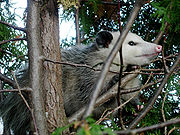
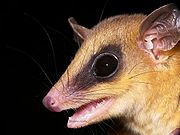
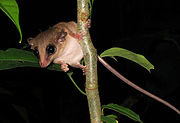
Order: DidelphimorphiaDidelphimorphiaOpossums make up the largest order of marsupials in the Western Hemisphere, including 103 or more species in 19 genera. They are also commonly called possums, though that term technically refers to Australian fauna of the suborder Phalangeriformes. The Virginia opossum was the first animal to be...
(common opossums)
----
Didelphimorphia is the order of common opossums of the Western Hemisphere
Western Hemisphere
The Western Hemisphere or western hemisphere is mainly used as a geographical term for the half of the Earth that lies west of the Prime Meridian and east of the Antimeridian , the other half being called the Eastern Hemisphere.In this sense, the western hemisphere consists of the western portions...
. Opossums probably diverged from the basic South America
South America
South America is a continent situated in the Western Hemisphere, mostly in the Southern Hemisphere, with a relatively small portion in the Northern Hemisphere. The continent is also considered a subcontinent of the Americas. It is bordered on the west by the Pacific Ocean and on the north and east...
n marsupial
Marsupial
Marsupials are an infraclass of mammals, characterized by giving birth to relatively undeveloped young. Close to 70% of the 334 extant species occur in Australia, New Guinea, and nearby islands, with the remaining 100 found in the Americas, primarily in South America, but with thirteen in Central...
s in the late Cretaceous
Cretaceous
The Cretaceous , derived from the Latin "creta" , usually abbreviated K for its German translation Kreide , is a geologic period and system from circa to million years ago. In the geologic timescale, the Cretaceous follows the Jurassic period and is followed by the Paleogene period of the...
or early Paleocene
Paleocene
The Paleocene or Palaeocene, the "early recent", is a geologic epoch that lasted from about . It is the first epoch of the Palaeogene Period in the modern Cenozoic Era...
.They are small to medium-sized marsupials, about the size of a large house cat
Cat
The cat , also known as the domestic cat or housecat to distinguish it from other felids and felines, is a small, usually furry, domesticated, carnivorous mammal that is valued by humans for its companionship and for its ability to hunt vermin and household pests...
, with a long snout and prehensile tail
Prehensile tail
A prehensile tail is the tail of an animal that has adapted to be able to grasp and/or hold objects. Fully prehensile tails can be used to hold and manipulate objects, and in particular to aid arboreal creatures in finding and eating food in the trees...
.
- Family: Didelphidae (American opossums)
- Subfamily: CaluromyinaeCaluromyinaeCaluromyinae is a subfamily of opossums. It includes the extant genera Caluromys, Caluromysiops and Glironia, as well as the extinct Pachybiotherium. It has sometimes been classed as a full family, Caluromyidae....
- Genus: Caluromys
- Derby's Woolly Opossum Caluromys derbianus LC
- Genus: Caluromys
- Subfamily: DidelphinaeDidelphinaeDidelphinae is a subfamily of opossums. Specimens have been collected throughout the Americas but are predominant in South and Central America....
- Genus: Chironectes
- Water OpossumWater OpossumThe water opossum , also locally known as the yapok, is a marsupial of the family Didelphidae. It is the only member of its genus, Chironectes...
Chironectes minimus LC
- Water Opossum
- Genus: DidelphisDidelphisThe six species in the genus Didelphis, commonly known as large American opossums, are members of the Didelphimorphia order....
- Common OpossumCommon OpossumThe common opossum , also called the southern or black-eared opossum, is a mammal species living from the northeast of Mexico to Bolivia, including the Lesser Antilles, where it is called manicou. It prefers the woods, but can also live in fields and cities...
Didelphis marsupialis LC - Virginia OpossumVirginia OpossumThe Virginia opossum , commonly known as the North American opossum or tlacuache in Mexico, is the only marsupial found in North America north of Mexico. A solitary and nocturnal animal about the size of a domestic cat, and thus the largest opossum, it is a successful opportunist...
Didelphis virginiana LC
- Common Opossum
- Genus: Marmosa
- Subgenus: MarmosaMarmosaThe nine species in the genus Marmosa are relatively small Neotropic members of the order Didelphimorphia. This genus is one of four that are known as mouse opossums. The others are Micoureus , Thylamys and Tlacuatzin, the grayish mouse opossum...
- Isthmian Mouse OpossumIsthmian mouse opossumThe Isthmian Mouse Opossum is a species of opossum in the family Didelphidae found in Colombia and Panama.Foraging along branches and vines for fruit and insects, with the help of a prehensile tail, M...
Marmosa isthmica - Mexican Mouse OpossumMexican Mouse OpossumThe Mexican mouse opossum is a species of Central American opossum in the family Didelphidae.-Range:It is found in Belize, Costa Rica, El Salvador, Guatemala, Honduras, eastern Mexico as far north as Tamaulipas, Nicaragua, and western Panama at elevations from sea level up to 3000 m ; most...
Marmosa mexicana LC - Robinson's Mouse OpossumRobinson's Mouse OpossumRobinson's Mouse Opossum is a species of opossum in the Didelphidae family.It is found in Belize, Colombia, Ecuador, Grenada, Honduras, Panama, Peru, Trinidad and Tobago, and Venezuela....
Marmosa robinsoni LC - Marmosa zeledoni
- Isthmian Mouse Opossum
- Subgenus: MicoureusMicoureusMicoureus is a genus of Neotropic opossums of the family Didelphidae. It includes the following species:* Alston's Mouse Opossum * White-bellied Woolly Mouse Opossum...
- Alston's Mouse OpossumAlston's Mouse OpossumAlston's Mouse Opossum , also known as Alston's Opossum, is a medium sized pouchless marsupial of the family Didelphidae. It is arboreal and nocturnal, inhabiting forests from Belize to northern Colombia. The main components of its diet are insects and fruits, but it may also eat small rodents,...
Marmosa alstoni LC
- Alston's Mouse Opossum
- Subgenus: Marmosa
- Genus: MarmosopsMarmosopsMarmosops is a genus of Neotropic opossums of the family Didelphidae. It includes the following species:* Genus Marmosops** Bishop's Slender Opossum ** Narrow-headed Slender Opossum...
- Panama Slender OpossumPanama Slender OpossumThe Panama slender opossum , also known as the slaty slender mouse opossum, is a species of opossum in the family Didelphidae. It is endemic to Panama, where it has been found in tropical rainforest habitats, including disturbed areas, at elevations from 500 to 1500 m. This opossum is mostly...
Marmosops invictus LC
- Panama Slender Opossum
- Genus: Metachirus
- Brown Four-eyed OpossumBrown Four-eyed OpossumThe Brown Four-eyed Opossum is a pouchless marsupial of the family Didelphidae. It is found in different forested habitats of Central and South America, from Nicaragua and to Paraguay and northern Argentina...
Metachirus nudicaudatus LC
- Brown Four-eyed Opossum
- Genus: Monodelphis
- Sepia Short-tailed OpossumSepia Short-tailed OpossumThe Sepia Short-tailed Opossum is a species of opossum in the Didelphidae family. It is found in Colombia, Ecuador, Panama, and Peru....
Monodelphis adusta LC
- Sepia Short-tailed Opossum
- Genus: PhilanderGray and black four-eyed opossumThe seven species in the genus Philander, commonly known as gray and black four-eyed opossums, are members of the order Didelphimorphia. Mature females have a well-developed marsupium. The tail appears to be hairless except for the proximal 5 or 6 cm, which has a few long hairs...
- Gray Four-eyed OpossumGray Four-eyed OpossumThe gray four-eyed opossum, Philander opossum, is an opossum species from Central and South America, ranging from southern Mexico to Peru, Bolivia and southwestern Brazil, at altitudes from sea level to 1600 m...
Philander opossum LC
- Gray Four-eyed Opossum
- Genus: TlacuatzinGrayish Mouse OpossumThe grayish mouse opossum is a species of opossum in the family Didelphidae, and is the sole member of the genus Tlacuatzin....
- Grayish Mouse OpossumGrayish Mouse OpossumThe grayish mouse opossum is a species of opossum in the family Didelphidae, and is the sole member of the genus Tlacuatzin....
Tlacuatzin canescens LC
- Grayish Mouse Opossum
- Genus: Chironectes
- Subfamily: Caluromyinae
Order: SireniaSireniaSirenia is an order of fully aquatic, herbivorous mammals that inhabit swamps, rivers, estuaries, marine wetlands, and coastal marine waters. Four species are living, in two families and genera. These are the dugong and manatees...
(manatees and dugongs)
----

Afrotheria
Afrotheria is a clade of mammals, the living members of which belong to groups from Africa or of African origin: golden moles, sengis , tenrecs, aardvarks, hyraxes, elephants and sea cows. The common ancestry of these animals was not recognized until the late 1990s...
ns in the Americas. However, a number proboscid
Proboscidea
Proboscidea is a taxonomic order containing one living family, Elephantidae, and several extinct families. This order was first described by J. Illiger in 1881 and encompasses the trunked mammals...
species, some of which survived until the arrival of Paleoindians, once inhabited the region. Mammoths
Columbian Mammoth
The Columbian Mammoth is an extinct species of elephant of the Quaternary period that appeared in North America during the late Pleistocene. It is believed by some authorities to be the same species as its slightly larger cousin, M...
, mastodons
American mastodon
The American mastodon is an extinct North American proboscidean that lived from about 3.7 million years ago until about 10,000 BC. It was the last surviving member of the mastodon family. Fossil finds range from present-day Alaska and New England in the north, to Florida, southern...
and gomphothere
Gomphothere
Gomphotheriidae is a diverse taxonomic family of extinct elephant-like animals , called gomphotheres. They were widespread in North America during the Miocene and Pliocene epochs, 12-1.6 million years ago. Some lived in parts of Eurasia, Beringia and, following the Great American Interchange,...
s all reached Central America.
- Family: Trichechidae
-
- Genus: Trichechus
- West Indian ManateeWest Indian ManateeThe West Indian Manatee is a manatee, and the largest surviving member of the aquatic mammal order Sirenia . The West Indian Manatee, Trichechus manatus, is a species distinct from the Amazonian Manatee, T. inunguis, and the West African Manatee, T. senegalensis...
Trichechus manatus VU
- West Indian Manatee
- Genus: Trichechus
-
Order: Cingulata (armadillos)
----
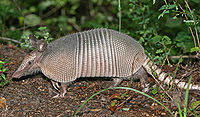
Pampatheriidae
Pampatheridae is an ancient family, now extinct, of large armadillo-like plantigrade armored xenarthrans. They are related to Glyptodontidae, an extinct family of much larger and more heavily armored xenarthrans, as well as to smaller extant armadillos...
and glyptodonts
Glyptodontidae
Glyptodonts were large, more heavily armored relatives of extinct pampatheres and modern armadillos.They first evolved during the Miocene in South America, which remained their center of species diversity...
, once lived in North and South America but went extinct following the appearance of humans.
- Family: Dasypodidae (armadillos)
- Subfamily: Dasypodinae
- Genus: DasypusDasypusDasypus is a genus of armadillo in the Dasypodidae family. It is the only genus in the subfamily Dasypodinae and contains the following species:*Nine-banded Armadillo, Dasypus novemcinctus*Seven-banded Armadillo, Dasypus septemcinctus...
- Nine-banded ArmadilloNine-banded ArmadilloThe nine-banded armadillo , or the nine-banded, long-nosed armadillo, is a species of armadillo found in North, Central, and South America, making it the most widespread of the armadillos...
Dasypus novemcinctus LC
- Nine-banded Armadillo
- Genus: Dasypus
- Subfamily: TolypeutinaeTolypeutinaeTolypeutinae is a subfamily of armadillo in the Dasypodidae family. It contains the following three extant genera:Kuntinaru*Cabassous*Priodontes*Tolypeutes...
- Genus: CabassousCabassousCabassous is a genus of armadillo in the Dasypodidae family. It contains the following species:*Northern Naked-tailed Armadillo, Cabassous centralis*Chacoan Naked-tailed Armadillo, Cabassous chacoensis...
- Northern Naked-tailed ArmadilloNorthern Naked-tailed ArmadilloThe Northern Naked-tailed Armadillo is a species of armadillo. It is found from Chiapas in southern Mexico to western Colombia, northwestern Ecuador and northwestern Venezuela, at altitudes from sea level to 3000 m...
Cabassous centralis DD
- Northern Naked-tailed Armadillo
- Genus: Cabassous
- Subfamily: Dasypodinae
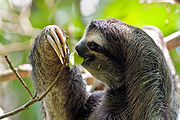
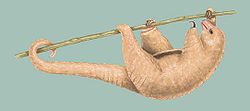

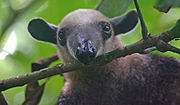
Order: PilosaPilosaThe order Pilosa is a group of placental mammals, extant today only in the Americas. It includes the anteaters and sloths, including the recently extinct ground sloths....
(sloths and anteaters)
----
The order Pilosa is confined to the Americas and contains the tree sloth
Sloth
Sloths are the six species of medium-sized mammals belonging to the families Megalonychidae and Bradypodidae , part of the order Pilosa and therefore related to armadillos and anteaters, which sport a similar set of specialized claws.They are arboreal residents of the jungles of Central and South...
s and anteater
Anteater
Anteaters, also known as antbear, are the four mammal species of the suborder Vermilingua commonly known for eating ants and termites. Together with the sloths, they compose the order Pilosa...
s (which include the tamandua
Tamandua
Tamandua is a genus of anteaters. It has two members: the Southern Tamandua and the Northern Tamandua . They live in forests and grasslands, are semi-arboreal, and possess partially prehensile tails. They mainly eat ants and termites, but they occasionally eat bees, beetles, and insect larvae...
s). Although their ancestral home is South America, all 5 extant genera and 6 of 10 extant species are present in Central America. Numerous ground sloth
Ground sloth
Ground sloths are a diverse group of extinct sloths, in the mammalian superorder Xenarthra. Their most recent survivors lived in the Antilles, where it has been proposed they may have survived until 1550 CE; however, the youngest AMS radiocarbon date reported is 4190 BP, calibrated to c. 4700 BP...
s, some of which reached the size of elephants, were once present in both North and South America, as well as the Antilles
Antilles
The Antilles islands form the greater part of the West Indies in the Caribbean Sea. The Antilles are divided into two major groups: the "Greater Antilles" to the north and west, including the larger islands of Cuba, Jamaica, Hispaniola , and Puerto Rico; and the smaller "Lesser Antilles" on the...
, but all went extinct following the arrival of humans.
- Suborder: Folivora
- Family: Bradypodidae (three-toed sloths)
- Genus: Bradypus
- Pygmy Three-toed SlothPygmy Three-toed SlothThe Pygmy Three-toed Sloth is a three-toed sloth. It is endemic to Isla Escudo de Veraguas, an island off the coast of Panama, which separated from the mainland nearly 8900 years ago. The species is thought to have originated from isolation of individuals from the mainland population of Bradypus...
Bradypus pygmaeus CR - Brown-throated Sloth Bradypus variegatus LC
- Pygmy Three-toed Sloth
- Genus: Bradypus
- Family: MegalonychidaeMegalonychidaeMegalonychidae is a group of sloths including the extinct Megalonyx and the living two toed sloths. Megalonychids first appeared in the early Oligocene, about 35 million years ago, in southern Argentina , and spread as far as the Antilles by the early Miocene...
(two-toed sloths)- Genus: Choloepus
- Hoffmann's Two-toed SlothHoffmann's Two-toed SlothHoffmann's two-toed sloth is a species of sloth from Central and South America. It is a solitary nocturnal and arboreal animal, found in mature and secondary rainforests and deciduous forests...
Choloepus hoffmanni LC
- Hoffmann's Two-toed Sloth
- Genus: Choloepus
- Family: Bradypodidae (three-toed sloths)
- Suborder: Vermilingua
- Family: CyclopedidaeCyclopedidaeCyclopedidae is a family of anteaters that includes the silky anteater and its extinct relatives....
(silky anteaters)- Genus: Cyclopes
- Silky AnteaterSilky AnteaterThe Silky Anteater or Pygmy Anteater is a species of anteater from Central and South America, ranging from extreme southern Mexico south to Brazil Delta Amacuro Venezuela and possibly Paraguay...
Cyclopes didactylus LC
- Silky Anteater
- Genus: Cyclopes
- Family: MyrmecophagidaeMyrmecophagidaeMyrmecophagidae is a family of anteaters, the name being derived from the Ancient Greek words for 'ant' and 'eat' . Myrmecophagids are native to Central and South America, from southern Mexico to northern Argentina. There are 2 genera and 3 species in the family, consisting of the Giant Anteater,...
(American anteaters)- Genus: Myrmecophaga
- Giant AnteaterGiant AnteaterThe Giant Anteater, Myrmecophaga tridactyla, is the largest species of anteater. It is the only species in the genus Myrmecophaga. It is found in Central and South America from Honduras to northern Argentina...
Myrmecophaga tridactyla VU
- Giant Anteater
- Genus: TamanduaTamanduaTamandua is a genus of anteaters. It has two members: the Southern Tamandua and the Northern Tamandua . They live in forests and grasslands, are semi-arboreal, and possess partially prehensile tails. They mainly eat ants and termites, but they occasionally eat bees, beetles, and insect larvae...
- Northern TamanduaNorthern TamanduaThe northern tamandua is a species of tamandua, a small anteater in the family Myrmecophagidae. They live in tropical and subtropical forests from southern Mexico, through Central America, and to the edge of the northern Andes....
Tamandua mexicana LC
- Northern Tamandua
- Genus: Myrmecophaga
- Family: Cyclopedidae
Order: Primates
----


Lemur
Lemurs are a clade of strepsirrhine primates endemic to the island of Madagascar. They are named after the lemures of Roman mythology due to the ghostly vocalizations, reflective eyes, and the nocturnal habits of some species...
s, monkey
Monkey
A monkey is a primate, either an Old World monkey or a New World monkey. There are about 260 known living species of monkey. Many are arboreal, although there are species that live primarily on the ground, such as baboons. Monkeys are generally considered to be intelligent. Unlike apes, monkeys...
s, and ape
Ape
Apes are Old World anthropoid mammals, more specifically a clade of tailless catarrhine primates, belonging to the biological superfamily Hominoidea. The apes are native to Africa and South-east Asia, although in relatively recent times humans have spread all over the world...
s, with the latter category including humans. It is divided into four main groupings: strepsirrhine
Strepsirrhini
The clade Strepsirrhini is one of the two suborders of primates. Madagascar's only non-human primates are strepsirrhines, and others can be found in southeast Asia and Africa...
s, tarsier
Tarsier
Tarsiers are haplorrhine primates of the genus Tarsius, a genus in the family Tarsiidae, which is itself the lone extant family within the infraorder Tarsiiformes...
s, monkeys of the New World
New World monkey
New World monkeys are the five families of primates that are found in Central and South America: Callitrichidae, Cebidae, Aotidae, Pitheciidae, and Atelidae. The five families are ranked together as the Platyrrhini parvorder and the Ceboidea superfamily, which are essentially synonymous since...
(parvorder
Order (biology)
In scientific classification used in biology, the order is# a taxonomic rank used in the classification of organisms. Other well-known ranks are life, domain, kingdom, phylum, class, family, genus, and species, with order fitting in between class and family...
Platyrrhini), and monkeys and apes of the Old World
Catarrhini
Catarrhini is one of the two subdivisions of the higher primates . It contains the Old World monkeys and the apes, which in turn are further divided into the lesser apes or gibbons and the great apes, consisting of the orangutans, gorillas, chimpanzees, bonobos, and humans...
. Central America's 6 genera of nonhuman primates compares with 19 in South America, 15 in Madagascar, 23 in Africa and 17 in Asia. Central American monkeys are recent immigrants from South America, where their ancestors arrived after rafting over
Rafting event
Oceanic dispersal is a type of biological dispersal that occurs when organisms transfer from one land mass to another by way of a sea crossing on large clumps of floating vegetation. Such matted clumps of vegetation are often seen floating down major rivers in the tropics and washing out to sea,...
from Africa
Africa
Africa is the world's second largest and second most populous continent, after Asia. At about 30.2 million km² including adjacent islands, it covers 6% of the Earth's total surface area and 20.4% of the total land area...
25 million years ago.
- Parvorder: Platyrrhini (New World monkeys)
- Family: Aotidae (night monkeys)
-
- Genus: AotusNight monkeyThe night monkeys, also known as the owl monkeys or douroucoulis, are the members of the genus Aotus of New World monkeys . They are widely distributed in the forests of Central and South America, from Panama south to Paraguay and northern Argentina...
- Panamanian Night MonkeyPanamanian Night MonkeyThe Panamanian night monkey or Chocoan night monkey is a species of night monkey formerly considered a subspecies of the gray-bellied night monkey of the family Aotidae. Its range consists of Panama and the Chocó region of Colombia. There are also unconfirmed reports of its occurrence in Costa...
Aotus zonalis DD – may be A. lemurinusGray-bellied Night MonkeyThe gray-bellied night monkey , also called the lemurine owl monkey, is a small New World monkey of the family Aotidae...
VU subspecies
- Panamanian Night Monkey
- Genus: Aotus
-
- Family: AtelidaeAtelidaeAtelidae is one of the five families of New World monkeys now recognised. It was formerly included in the family Cebidae. Atelids are generally larger monkeys; the family includes the howler, spider, woolly and woolly spider monkeys...
(howler, spider and woolly monkeys)- Subfamily: Alouattinae
- Genus: Alouatta
- Coiba Island HowlerCoiba Island HowlerThe Coiba Island howler is a species of howler monkey, a type of New World monkey, endemic to Panama. Although the Coiba Island howler is generally recognized as a separate species, mitochondrial DNA testing is inconclusive as to whether it is actually a subspecies of the mantled howler...
Alouatta coibensis VU – may be A. palliata subspecies - Mantled HowlerMantled HowlerThe mantled howler , or golden-mantled howling monkey, is a species of howler monkey, a type of New World monkey, from Central and South America. It is one of the monkey species most often seen and heard in the wild in Central America...
Alouatta palliata LC - Guatemalan Black HowlerGuatemalan Black HowlerThe Guatemalan black howler, or Yucatan black howler, is a species of howler monkey, a type of New World monkey, from Central America. It is found in Belize, Guatemala and Mexico, in and near the Yucatan Peninsula. It lives in evergreen, semi-deciduous and lowland rain forests...
Alouatta pigra EN
- Coiba Island Howler
- Genus: Alouatta
- Subfamily: AtelinaeAtelinaeAtelinae is a subfamily of New World monkeys in the family Atelidae, and includes the various spider and woolly monkeys. The primary distinguishing feature of the atelines is their long prehensile tail which can support their entire body weight....
- Genus: Ateles
- Black-headed Spider MonkeyBlack-headed Spider MonkeyThe Black-headed spider monkey, Ateles fusciceps, is a species of spider monkey, a type of New World monkey, from Central and South America. It is found in Colombia, Nicaragua and Panama. Although primatologists such as Colin Groves follow Kellogg and Goldman in treating A...
Ateles fusciceps CR - Geoffroy's Spider MonkeyGeoffroy's Spider MonkeyGeoffroy's spider monkey, Ateles geoffroyi, also known as black-handed spider monkey, is a species of spider monkey, a type of New World monkey, from Central America, parts of Mexico and possibly a small portion of Colombia. There are at least five subspecies. Some primatologists classify the...
Ateles geoffroyi EN
- Black-headed Spider Monkey
- Genus: Ateles
- Subfamily: Alouattinae
- Family: CebidaeCebidaeThe Cebidae is one of the five families of New World monkeys now recognised. It includes the capuchin monkeys and squirrel monkeys. These species are found throughout tropical and subtropical South and Central America.-Characteristics:...
(capuchin and squirrel monkeys, marmosets, tamarins)- Subfamily: CallitrichinaeCallitrichinaeThe Callitrichidae is one of five families of New World monkeys. The family includes several genera, including the marmosets, tamarins, and lion tamarins...
- Genus: Saguinus
- Geoffroy's TamarinGeoffroy's TamarinGeoffroy's tamarin , also known as the Panamanian, red-crested or rufous-naped tamarin, is a tamarin, a type of small monkey, found in Panama and Colombia. It is predominantly black and white, with a reddish nape. Diurnal, Geoffroy's tamarin spends most of its time in trees, but does come down to...
Saguinus geoffroyi LC
- Geoffroy's Tamarin
- Genus: Saguinus
- Subfamily: Cebinae
- Genus: CebusCEBusCEBus, short for Consumer Electronics Bus, also known as EIA-600, is a set of electrical standards and communication protocols for electronic devices to transmit commands and data...
- White-headed CapuchinWhite-headed CapuchinThe white-headed capuchin , also known as the white-faced capuchin or white-throated capuchin, is a medium-sized New World monkey of the family Cebidae, subfamily Cebinae...
Cebus capucinus LC
- White-headed Capuchin
- Genus: Saimiri
- Central American Squirrel MonkeyCentral American Squirrel MonkeyThe Central American squirrel monkey is a squirrel monkey species from the Pacific coast of Costa Rica and Panama. It is restricted to the northwestern tip of Panama near the border with Costa Rica, and the central and southern Pacific coast of Costa Rica, primarily in Manuel Antonio and Corcovado...
Saimiri oerstedii VU
- Central American Squirrel Monkey
- Genus: Cebus
- Subfamily: Callitrichinae
- Family: Aotidae (night monkeys)
Order: RodentRodentRodentia is an order of mammals also known as rodents, characterised by two continuously growing incisors in the upper and lower jaws which must be kept short by gnawing....
ia (rodents)
----
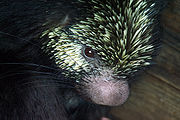
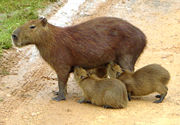


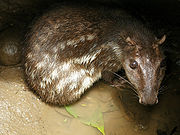
Incisor
Incisors are the first kind of tooth in heterodont mammals. They are located in the premaxilla above and mandible below.-Function:...
s in the upper and lower jaw which grow continually and must be keep short by gnawing. Most rodents are small, although the capybara
Capybara
The capybara , also known as capivara in Portuguese, and capibara, chigüire in Venezuela, Colombia, and Ecuador ronsoco in Peru, chigüiro, and carpincho in Spanish, is the largest living rodent in the world. Its closest relatives are agouti, chinchillas, coyphillas, and guinea pigs...
can weigh up to 45 kg (100 lb). Central America's 11 species of caviomorph rodents are recent immigrants from South America
South America
South America is a continent situated in the Western Hemisphere, mostly in the Southern Hemisphere, with a relatively small portion in the Northern Hemisphere. The continent is also considered a subcontinent of the Americas. It is bordered on the west by the Pacific Ocean and on the north and east...
, where their ancestors washed ashore after rafting across
Rafting event
Oceanic dispersal is a type of biological dispersal that occurs when organisms transfer from one land mass to another by way of a sea crossing on large clumps of floating vegetation. Such matted clumps of vegetation are often seen floating down major rivers in the tropics and washing out to sea,...
the Atlantic
Atlantic Ocean
The Atlantic Ocean is the second-largest of the world's oceanic divisions. With a total area of about , it covers approximately 20% of the Earth's surface and about 26% of its water surface area...
from Africa
Africa
Africa is the world's second largest and second most populous continent, after Asia. At about 30.2 million km² including adjacent islands, it covers 6% of the Earth's total surface area and 20.4% of the total land area...
30 million years ago. The remainder of Central America's rodents are of Nearctic origin. Ancestral sigmodontine
Sigmodontinae
The subfamily Sigmodontinae is one of the most diverse groups of mammals. It includes New World rats and mice, with at least 376 species. Many authorities include the Neotominae and Tylomyinae as part of a larger definition of Sigmodontinae. When those genera are included, the species count...
rodents apparently island-hopped
Island hopping
Island hopping is a term that refers to the means of crossing an ocean by a series of shorter journeys between islands, as opposed to a single journey directly across the ocean to the destination.- Forms :...
from Central America to South America about 5 million years ago, prior to the formation of the Panamanian land bridge
Isthmus of Panama
The Isthmus of Panama, also historically known as the Isthmus of Darien, is the narrow strip of land that lies between the Caribbean Sea and the Pacific Ocean, linking North and South America. It contains the country of Panama and the Panama Canal...
. They went on to diversify
Speciation
Speciation is the evolutionary process by which new biological species arise. The biologist Orator F. Cook seems to have been the first to coin the term 'speciation' for the splitting of lineages or 'cladogenesis,' as opposed to 'anagenesis' or 'phyletic evolution' occurring within lineages...
explosively, and now comprise 60% of South America's rodent species.
- Suborder: HystricomorphaHystricomorphaThe term Hystricomorpha has had many definitions throughout its history. In the broadest sense it refers to any rodent with a hystricomorphous zygomasseteric system. This includes the Hystricognathi, Ctenodactylidae, Anomaluridae, and Pedetidae...
- Parvorder: CaviomorphaCaviomorphaCaviomorpha is the rodent infraorder or parvorder that unites all South American hystricognaths. It is supported by both fossil and molecular evidence.-Origin:...
- Family: Erethizontidae (New World porcupines)
- Subfamily: Erethizontinae
- Genus: Coendou
- Rothschild's PorcupineRothschild's PorcupineRothschild's Porcupine, Coendou rothschildi, is a species of rodent in the family Erethizontidae.It is usually considered endemic to Panama. A population in western Ecuador belongs either to this species or to Coendou bicolor....
Coendou rothschildi LC
- Rothschild's Porcupine
- Genus: SphiggurusSphiggurusSphiggurus is a genus of New World porcupine. It contains the following species:*Sphiggurus ichillus - Streaked Dwarf Porcupine*Sphiggurus insidiosus - Bahia Porcupine*Sphiggurus melanurus - Black-tailed Hairy Dwarf Porcupine...
- Mexican Hairy Dwarf PorcupineMexican Hairy Dwarf PorcupineThe Mexican Hairy Dwarf Porcupine or Mexican Tree Porcupine is a species of rodent in the family Erethizontidae. It is found in Costa Rica, El Salvador, Guatemala, Honduras, Mexico, Panama, possibly Belize, and possibly Nicaragua.-References:...
Sphiggurus mexicanus LC
- Mexican Hairy Dwarf Porcupine
- Genus: Coendou
- Subfamily: Erethizontinae
- Family: CaviidaeCaviidaeThe cavy family is a family of rodents native to South America, and including the domestic guinea pig, wild cavies, and the capybara, among other animals...
(guinea pigs)- Subfamily: Hydrochaeridae (capybaras)
- Genus: HydrochoerusHydrochoerusThe genus Hydrochoerus contains two living species of capybaras from South America and Panama, the largest living rodents in the world. The genus name is derived from the Greek ὕδωρ plus χοίρος ....
- Lesser CapybaraLesser capybaraThe lesser capybara is a large semiaquatic rodent of the family Caviidae found in eastern Panama, northwestern Colombia and western Venezuela. It was recognized as a distinct subspecies of capybara in 1912, and was elevated to species status in 1991. It breeds year-round, with an average litter...
Hydrochoerus isthmius DD
- Lesser Capybara
- Genus: Hydrochoerus
- Subfamily: Hydrochaeridae (capybaras)
- Family: DasyproctidaeDasyproctidaeDasyproctidae is a family of large South American rodents, comprising the agoutis and acouchis. Their fur is a reddish or dark colour above, with a paler underside. They are herbivorous, often feeding on ripe fruit that falls from trees...
-
- Genus: Dasyprocta
- Coiban AgoutiCoiban AgoutiThe Coiban Agouti is a species of rodent in the family Dasyproctidae.It is endemic to Panama. It is threatened by habitat loss....
Dasyprocta coibae VU - Mexican AgoutiMexican AgoutiThe Mexican Agouti is a species of rodent in the family Dasyproctidae.It is found in Cuba and Mexico.It is threatened by habitat loss....
Dasyprocta mexicana CR - Central American AgoutiCentral American AgoutiThe Central American Agouti is an agouti species from the family Dasyproctidae. The species is widespread in Mesoamerica and South America. The northern section of the range occurs from Chiapas and the Yucatan Peninsula to northern Ecuador and Colombia and western Venezuela...
Dasyprocta punctata LC - Ruatan Island AgoutiRuatan Island AgoutiThe Ruatan Island Agouti is a species of rodent in the family Dasyproctidae.It is endemic to Honduras. It is threatened by habitat loss....
Dasyprocta ruatanica EN
- Coiban Agouti
- Genus: Dasyprocta
-
- Family: CuniculidaePacaThe Lowland Paca , also known as the Spotted Paca, is a large rodent found in tropical and sub-tropical America, from East-Central Mexico to Northern Argentina...
-
- Genus: CuniculusPacaThe Lowland Paca , also known as the Spotted Paca, is a large rodent found in tropical and sub-tropical America, from East-Central Mexico to Northern Argentina...
- Lowland Paca Cuniculus paca LC
- Genus: Cuniculus
-
- Family: Echimyidae
- Subfamily: Echimyinae
- Genus: DiplomysDiplomysDiplomys is a genus of rodent in the Echimyidae family. They are found in Ecuador, Colombia and Panama.It contains the following species:* Arboreal Soft-furred Spiny Rat * Rufous Tree Rat...
- Rufous Soft-furred Spiny-ratRufous Soft-furred Spiny-ratThe Rufous Soft-furred Spiny-rat is a species of rodent in the Echimyidae family.It is found in Colombia, Ecuador, and Panama.-References:...
Diplomys labilis LC
- Rufous Soft-furred Spiny-rat
- Genus: Diplomys
- Subfamily: Eumysopinae
- Genus: Hoplomys
- Armored RatArmored RatThe Armored Rat is a species of rodent in the family Echimyidae. It is monotypic within the genus Hoplomys. It is found in Latin America, from northern Honduras to northwest Ecuador...
Hoplomys gymnurus LC
- Armored Rat
- Genus: ProechimysProechimysProechimys is a genus of South American spiny rats of the family Echimyidae....
- Tome's Spiny-ratTome's Spiny-ratTome's Spiny-rat , also known as the Central American spiny rat, is a species of spiny rat distributed from Honduras to Ecuador. The IUCN classifies it as least concern under P. semispinosus and near threatened as P. gorgonae.-References:*Woods, C. A. and C. W. Kilpatrick. 2005. Hystricognathi...
Proechimys semispinosus LC
- Tome's Spiny-rat
- Genus: Hoplomys
- Subfamily: Echimyinae
- Family: Capromyidae
- Subfamily: Capromyinae
- Genus: GeocapromysGeocapromysGeocapromys is a genus of rodent, comprising two extant species of hutia. The Bahamian Hutia or Ingraham's Hutia is native to the Bahamas, while the Jamaican Hutia , which is also known as the Jamaican Coney or Brown's Hutia, is endemic to Jamaica.The Little Swan Island Hutia Geocapromys is a...
- Little Swan Island hutiaLittle Swan Island hutiaThe Little Swan Island Hutia is an extinct species of rodent that lived on the Swan Islands, off north-eastern Honduras in the Caribbean...
†Geocapromys thoracatus EX
- Little Swan Island hutia
- Genus: Geocapromys
- Subfamily: Capromyinae
- Family: Erethizontidae (New World porcupines)
- Parvorder: Caviomorpha
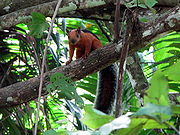


- Suborder: SciuromorphaSciuromorphaThe term Sciuromorpha has referred to numerous groups of rodents, but the only family common to all variations is the Sciuridae, the squirrels. Most definitions also include the Mountain Beaver....
- Family: Sciuridae (squirrels)
- Subfamily: SciurinaeSciurinaeThe Sciurinae is a subfamily of squirrels in the . It unites the flying squirrels with certain related tree squirrels. Older sources place the flying squirrels in a separate subfamily and unite all remaining sciurids into the subfamily Sciurinae, but this has been strongly refuted by genetic...
- Tribe: SciuriniSciuriniSciurini is a tribe that includes about forty species of squirrels, mostly from the Americas. It includes five living genera—the American dwarf squirrels, Microsciurus; the Bornean Rheithrosciurus; the widespread American and Eurasian tree squirrels of the genus Sciurus, which includes some of the...
- Genus: MicrosciurusMicrosciurusMicrosciurus or dwarf squirrels is a genus of squirrels from the tropical regions of Central and South America.There are four recognized species, however, recent DNA analysis has shown that there is some confusion regarding the traditional classification of the Microsciurus species:Genus...
- Central American Dwarf SquirrelCentral American Dwarf SquirrelThe Central American dwarf squirrel is a small tree squirrel in the genus Microsciurus and tribe Sciurini found in Colombia, Costa Rica, Nicaragua, and Panama....
Microsciurus alfari LC - Western Dwarf SquirrelWestern Dwarf SquirrelThe western dwarf squirrel is a small tree squirrel in the genus Microsciurus and tribe Sciurini found in Colombia, Ecuador, and Panama....
Microsciurus mimulus LC
- Central American Dwarf Squirrel
- Genus: SciurusSciurusThe genus Sciurus contains most of the common, bushy-tailed squirrels in North America, Europe, temperate Asia, Central America and South America.-Species:There are 30 species.Genus Sciurus - Tree squirrels*Subgenus Sciurus...
- Red-bellied squirrelRed-bellied squirrelThe Red-bellied squirrel is a species of squirrel. Until recently, it was described as a species in the genus Callosciurus, but since the 1990s it is generally placed in its own genus Rubrisciurus. It is endemic on the Indonesian island of Sulawesi. With a length of 25 cm , it is rather large...
Sciurus aureogaster VU - Deppe's SquirrelDeppe's SquirrelDeppe's squirrel is a species of tree squirrel in the genus Sciurus endemic to Belize, Costa Rica, El Salvador, Guatemala, Honduras, Mexico, and Nicaragua....
Sciurus deppei LC - Red-tailed SquirrelRed-tailed SquirrelThe red-tailed Squirrel is a tree squirrel in the genus Sciurus endemic to South America. It is found in Colombia, Costa Rica, Ecuador, Panama, Trinidad and Tobago, and Venezuela....
Sciurus granatensis LC - Richmond's SquirrelRichmond's SquirrelRichmond's squirrel is a tree squirrel in the genus Sciurus endemic to Nicaragua. Its natural habitat is tropical and subtropical dry broadleaf forests....
Sciurus richmondi NT - Variegated SquirrelVariegated SquirrelThe variegated squirrel is a tree squirrel in the genus Sciurus endemic to Costa Rica, El Salvador, Guatemala, Honduras, southern Mexico, Nicaragua, and Panama.-Subspecies:In alphabetical order except for nominate species....
Sciurus variegatoides LC - Yucatan SquirrelYucatan SquirrelThe Yucatan squirrel is a tree squirrel in the genus Sciurus endemic to Belize, Guatemala, and Mexico.These squirrels live in forests, active during the day and resting at night, spending most of their time in trees. Their dreys are built in branches from leaves and twigs. The squirrel's main...
Sciurus yucatanensis LC
- Red-bellied squirrel
- Genus: Syntheosciurus
- Bangs's Mountain SquirrelBangs's Mountain SquirrelBangs's Mountain Squirrel is a nearly unknown species of tree squirrel, that only lives in Costa Rica and Panama. It can be found in mountain rain forests at an altitude between 1900 and 2600 meters, and lives mainly in the tree tops, but sometimes on the forest floor as well...
Syntheosciurus brochus NT
- Bangs's Mountain Squirrel
- Genus: Microsciurus
- Tribe: Sciurini
- Subfamily: Sciurinae
- Family: Sciuridae (squirrels)
- Suborder: CastorimorphaCastorimorphaCastorimorpha is the suborder of rodents containing the beavers, the pocket gophers, and the kangaroo rats and mice.-Taxonomy:*Suborder Castorimorpha**Superfamily Castoroidea***Family †Eutypomyidae***Family Castoridae - beavers...
- Family: Geomyidae
-
- Genus: OrthogeomysOrthogeomysOrthogeomys is a genus of rodent in the Geomyidae family, found in Mexico, Central America and Colombia.It contains the following species:* Chiriqui Pocket Gopher * Cherrie's Pocket Gopher...
- Chiriqui Pocket GopherChiriqui Pocket GopherThe Chiriqui Pocket Gopher is a species of rodent in the Geomyidae family. It is found in Costa Rica and Panama....
Orthogeomys cavator LC - Cherrie's Pocket GopherCherrie's Pocket GopherCherrie's Pocket Gopher is a species of rodent in the Geomyidae family. It is endemic to Costa Rica. It is threatened by habitat loss....
Orthogeomys cherriei LC - Oaxacan Pocket GopherOaxacan Pocket GopherThe Oaxacan Pocket Gopher is a species of rodent in the Geomyidae family. It is endemic to Mexico....
Orthogeomys cuniculus DD - Darien Pocket GopherDarien Pocket GopherThe Darien Pocket Gopher is a species of rodent in the Geomyidae family. It is endemic to Panama....
Orthogeomys dariensis LC - Giant Pocket GopherGiant Pocket GopherThe Giant Pocket Gopher is a species of rodent in the Geomyidae family. It is found in Guatemala, Honduras, and Mexico....
Orthogeomys grandis LC - Variable Pocket GopherVariable Pocket GopherThe Variable Pocket Gopher is a species of rodent in the Geomyidae family. It is endemic to Costa Rica, usually in grasslands and tropical forests in higher altitudes up to 8,000 feet...
Orthogeomys heterodus LC - Hispid Pocket GopherHispid Pocket GopherThe Hispid Pocket Gopher is a species of rodent in the Geomyidae family. It is found in Belize, Guatemala, Honduras, and Mexico....
Orthogeomys hispidus LC - Nicaraguan Pocket GopherNicaraguan Pocket GopherThe Nicaraguan Pocket Gopher is a species of rodent in the Geomyidae family. It is found in Honduras and Nicaragua....
Orthogeomys matagalpae LC - Underwood's Pocket GopherUnderwood's Pocket GopherUnderwood's Pocket Gopher is a species of rodent in the Geomyidae family. It is endemic to Costa Rica....
Orthogeomys underwoodi LC
- Chiriqui Pocket Gopher
- Genus: Orthogeomys
-
- Family: HeteromyidaeHeteromyidaeThe family of rodents that include kangaroo rats, kangaroo mice and rock pocket mice is the Heteromyidae family. Most heteromyids live in complex burrows within the deserts and grasslands of western North America, though species within the Heteromys and Liomys genera are also found in forests and...
- Subfamily: Heteromyinae
- Genus: HeteromysHeteromysHeteromys is a genus of rodent in the family Heteromyidae.It contains the following species:* Trinidad Spiny Pocket Mouse * Southern Spiny Pocket Mouse...
- Southern Spiny Pocket MouseSouthern Spiny Pocket MouseThe Southern Spiny Pocket Mouse is a species of rodent in the Heteromyidae family. It is found in Colombia, Ecuador, and Panama....
Heteromys australis LC - Desmarest's Spiny Pocket MouseDesmarest's Spiny Pocket MouseDesmarest's Spiny Pocket Mouse is a species of rodent in the Heteromyidae family. It is found in Colombia, Costa Rica, El Salvador, Guatemala, Honduras, Mexico, Nicaragua, and Panama....
Heteromys desmarestianus LC - Gaumer's Spiny Pocket MouseGaumer's Spiny Pocket MouseGaumer's Spiny Pocket Mouse is a species of rodent in the Heteromyidae family. It ranges over northern Belize and Guatemala and the Yucatán Peninsula of Mexico, where it lives in lowland semideciduous forest and thorn scrub. The species is nocturnal and terrestrial; it is solitary and strongly...
Heteromys gaumeri LC - Nelson's Spiny Pocket MouseNelson's Spiny Pocket MouseNelson's Spiny Pocket Mouse is a species of rodent in the Heteromyidae family. It is endemic to Mexico and Guatemala.Its natural habitat is subtropical or tropical moist lowland forests. It is threatened by habitat loss....
Heteromys nelsoni EN - Heteromys nubicolens
- Mountain Spiny Pocket MouseMountain Spiny Pocket MouseThe Mountain Spiny Pocket Mouse is a species of rodent in the Heteromyidae family. It is endemic to Costa Rica.Its natural habitat is subtropical or tropical moist lowland forests. It is threatened by habitat loss....
Heteromys oresterus LC
- Southern Spiny Pocket Mouse
- Genus: LiomysLiomysLiomys is a genus of rodent in the Heteromyidae family.It contains the following species:* Panamanian Spiny Pocket Mouse * Mexican Spiny Pocket Mouse * Painted Spiny Pocket Mouse...
- Panamanian Spiny Pocket MousePanamanian Spiny Pocket MouseThe Panamanian Spiny Pocket Mouse is a species of rodent in the Heteromyidae family. It is endemic to Panama.It is threatened by habitat loss....
Liomys adspersus LC - Painted Spiny Pocket MousePainted Spiny Pocket MouseThe Painted Spiny Pocket Mouse is a species of rodent in the Heteromyidae family. It is found in Guatemala and Mexico....
Liomys pictus LC - Salvin's Spiny Pocket MouseSalvin's Spiny Pocket MouseSalvin's Spiny Pocket Mouse is a species of rodent in the Heteromyidae family. It is found in Costa Rica, El Salvador, Guatemala, Honduras, Mexico, and Nicaragua....
Liomys salvini LC
- Panamanian Spiny Pocket Mouse
- Genus: Heteromys
- Subfamily: Heteromyinae
- Family: Geomyidae

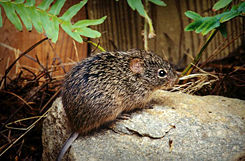
- Suborder: MyomorphaMyomorphaSuborder Myomorpha contains 1,137 species of mouse-like rodents, nearly a quarter of all mammal species. Included are mice, rats, gerbils, hamsters, lemmings and voles. They are grouped according to the structure of the jaw and the structure of the molar teeth. Both their medial and lateral...
- Family: CricetidaeCricetidaeThe Cricetidae are a family of rodents in the large and complex superfamily Muroidea. It includes true hamsters, voles, lemmings, and New World rats and mice...
- Subfamily: ArvicolinaeArvicolinaeThe Arvicolinae are a subfamily of rodents that includes the voles, lemmings, and muskrats. They are most closely related to the other subfamilies in the Cricetidae . Some authorities place the subfamily Arvicolinae in the family Muridae along with all other members of the superfamily Muroidea...
- Genus: MicrotusMicrotusThe genus Microtus is a group of voles found in North America, Europe and northern Asia. The genus name refers to the small ears of these animals. There are 62 species in the genus....
- Guatemalan VoleGuatemalan VoleThe Guatemalan vole is a species of rodent in the family Cricetidae.It is found in Guatemala and Chiapas, Mexico in montane pine-oak forest and meadow at elevations between 2600 to 3100 m. It is terrestrial and probably diurnal or crepuscular....
Microtus guatemalensis NT
- Guatemalan Vole
- Genus: Microtus
- Subfamily: TylomyinaeTylomyinaeThe subfamily Tylomyinae consists of several species of New World rats and mice including the vesper and climbing rats. They are not as well known as their relatives in the subfamilies Sigmodontinae and Neotominae...
- Genus: Nyctomys
- Sumichrast's vesper ratSumichrast's vesper ratSumichrast's vesper rat is a rodent of the family Cricetidae found from southern Mexico to Panama. The adult length is 11–13 cm, with a tail length of 8.5-15.5 cm. It is one of the more brightly coloured rats, with a pinkish-brown back and white underparts. The first toe on each foot is...
Nyctomys sumichrasti LC
- Sumichrast's vesper rat
- Genus: Otonyctomys
- Hatt's Vesper RatHatt's Vesper RatHatt's vesper rat , also known as the Yucatán vesper rat, is a species of rodent in the family Cricetidae. It is the only species in the genus Otonyctomys. It is named for its discoverer, Robert T...
Otonyctomys hatti LC
- Hatt's Vesper Rat
- Genus: Ototylomys
- Big-eared Climbing RatBig-Eared Climbing RatThe Big-eared Climbing Rat is a species of rodent in the family Cricetidae.It is found in Belize, Costa Rica, El Salvador, Guatemala, Honduras, Mexico, and Nicaragua.-References:...
Ototylomys phyllotis LC
- Big-eared Climbing Rat
- Genus: TylomysTylomysTylomys is a genus of rodent in the family Cricetidae.It contains the following species:* Chiapan Climbing Rat * Fulvous-bellied Climbing Rat * Mira Climbing Rat...
- Chiapan Climbing RatChiapan Climbing RatThe Chiapan Climbing Rat is a species of rodent in the family Cricetidae.It is found only in Mexico.-References:* Baillie, J. 1996. . Downloaded on 20 July 2007....
Tylomys bullaris CR - Fulvous-bellied Climbing RatFulvous-bellied Climbing RatThe Fulvous-bellied Climbing Rat is a species of rodent in the family Cricetidae.It is found only in Panama.-References:* Pino, J., Samudio, R. & Reid, F 2008. . Downloaded on 27 February 2009....
Tylomys fulviventer DD - Peters's Climbing RatPeters's Climbing RatPeters's Climbing Rat is a species of rodent in the family Cricetidae.It is found in Belize, El Salvador, Guatemala, Honduras, Mexico, and Nicaragua.-References:* Baillie, J. 1996. . Downloaded on 20 July 2007....
Tylomys nudicaudus LC - Panamanian Climbing RatPanamanian Climbing RatThe Panamanian Climbing Rat is a species of rodent in the family Cricetidae. It is endemic to Panama.-Literature cited:*Alston, E. R. 1882. . R.H. Porter, 220 pp....
Tylomys panamensis DD - Tumbala Climbing RatTumbala Climbing RatThe Tumbala Climbing Rat is a species of rodent in the family Cricetidae.It is found only in Mexico.-References:* Baillie, J. 1996. . Downloaded on 20 July 2007....
Tylomys tumbalensis CR - Watson's Climbing RatWatson's Climbing RatWatson's Climbing Rat is a species of rodent in the family Cricetidae.It is found in Costa Rica and Panama.-References:* Baillie, J. 1996. . Downloaded on 20 July 2007....
Tylomys watsoni LC
- Chiapan Climbing Rat
- Genus: Nyctomys
- Subfamily: NeotominaeNeotominaeNeotominae is a subfamily of the family Cricetidae. It consists of four tribes, 16 genera, and many species of New World rats and mice, predominantly found in North America. Among them are the well-known deer mice, white-footed mice, packrats, and grasshopper mice.Neotomines are related to the...
- Genus: BaiomysBaiomysBaiomys is the genus of New World pygmy mice. Together with Scotinomys, it forms the tribe Baiomyini. It currently contains two extant species:*Southern Pygmy Mouse, Baiomys musculus*Northern Pygmy Mouse, Baiomys taylori-References:...
- Southern Pygmy MouseSouthern Pygmy MouseThe Southern Pygmy Mouse is a species of rodent in the family Cricetidae.It is found in El Salvador, Guatemala, Honduras, Mexico, and Nicaragua. Synonyms: Baiomys brunneus The Southern Pygmy Mouse (Baiomys musculus) is a species of rodent in the family Cricetidae.It is found in El Salvador,...
Baiomys musculus LC
- Southern Pygmy Mouse
- Genus: HabromysHabromysHabromys is a genus of rodent in the family Cricetidae, found in Mexico and Central America.It contains the following species:* Chinanteco Deermouse * Delicate Deermouse ...
- Crested-tailed Deer MouseCrested-Tailed Deer MouseThe Crested-tailed Deermouse is a species of rodent in the family Cricetidae. It is found in El Salvador, Guatemala, and Mexico.-References:...
Habromys lophurus NT
- Crested-tailed Deer Mouse
- Genus: IsthmomysIsthmomysIsthmomys is a genus of rodent in the family Cricetidae, belonging to the tribe Reithrodontomyini. Species are:*Yellow Isthmus Rat *Mt. Pirri Isthmus Rat -References:...
- Yellow Isthmus RatYellow Isthmus RatThe Yellow Isthmus Rat is a species of rodent in the family Cricetidae. It is found only in Panama. It was discovered by W. W. Brown, Jr. on the southern slope of Volcan de Chiriqui...
Isthmomys flavidus NT - Mt. Pirri Isthmus RatMt. Pirri Isthmus RatThe Mt. Pirri Isthmus Rat is a species of rodent in the family Cricetidae.Its natural habitat is subtropical or tropical moist lowland forests. It is found only in Panama. At the time of its discovery it was considered as the “most common rat of southeastern Panama” . Found only in the eastern...
Isthmomys pirrensis LC
- Yellow Isthmus Rat
- Genus: Neotoma
- Nicaraguan WoodratNicaraguan WoodratThe Nicaraguan Woodrat is a species of rodent in the family Cricetidae.It is found in Honduras and Nicaragua.-References:...
Neotoma chrysomelas LC - Mexican WoodratMexican WoodratThe Mexican Woodrat is a medium-sized rat occurring in the United States from Utah and Colorado south through New Mexico and parts of Arizona and Trans-Pecos Texas. Its range continues south in the highlands to Honduras...
Neotoma mexicana LC
- Nicaraguan Woodrat
- Genus: PeromyscusPeromyscusThe genus Peromyscus contains the animal species commonly referred to as deer mice. This is a genus of New World mouse only distantly related to the common house mouse and laboratory mouse, Mus musculus...
- Aztec MouseAztec MouseThe Aztec Mouse is a species of rodent in the family Cricetidae.It is found in El Salvador, Guatemala, Honduras, and Mexico.- Habitat :...
Peromyscus aztecus LC - Big Deer MouseBig Deer MouseThe Big Deer Mouse is a species of rodent in the family Cricetidae.It is found only in Guatemala.-References:* Baillie, J. 1996. . Downloaded on 19 July 2007....
Peromyscus grandis NT - Guatemalan Deer MouseGuatemalan Deer MouseThe Guatemalan Deer Mouse is a species of rodent in the family Cricetidae.It is found in Guatemala and Mexico.-References:* Baillie, J. 1996. . Downloaded on 19 July 2007....
Peromyscus guatemalensis LC - Naked-eared Deer MouseNaked-Eared Deer MouseThe Naked-eared Deer Mouse is a species of rodent in the family Cricetidae.It is found in El Salvador, Guatemala, Honduras, Mexico, and Nicaragua.-References:* Baillie, J. 1996. . Downloaded on 19 July 2007....
Peromyscus gymnotis LC - White-footed MouseWhite-footed mouseWhite-footed Mouse is a rodent native to North America. It ranges from Ontario, Quebec, Labrador and the Maritime Provinces to the southwest USA and Mexico. It is also known as the Woodmouse, particularly in Texas.Adults are in length, not counting the tail, which can add another . A young adult...
Peromyscus leucopus LC - Nimble-footed MouseNimble-Footed MouseThe nimble-footed mouse is a species of rodent in the family Cricetidae. It is found only in Mexico.-Description:...
Peromyscus levipes LC - Plateau MousePlateau MouseThe Plateau Mouse is a species of rodent in the family Cricetidae.It is found only in Mexico.-References:* Baillie, J. 1996. . Downloaded on 19 July 2007....
Peromyscus melanophrys LC - Maya MouseMaya MouseThe Maya Mouse is a species of rodent in the family Cricetidae.It is found only in Guatemala.-References:* Reid, F., Pérez, S., Woodman, N. & Matson, J. 2008. . Downloaded on 28 February 2009....
Peromyscus mayensis CR - Mexican Deer MouseMexican Deer MouseThe Mexican deer mouse is a species of forest-dwelling rodent in the family Cricetidae. It is found in southern Mexico and throughout much of Central America.-Description:...
Peromyscus mexicanus LC - Stirton's Deer MouseStirton's Deer MouseStirton's Deer Mouse is a species of rodent in the family Cricetidae.It is found in El Salvador, Guatemala, Honduras, and Nicaragua.-References:* Baillie, J. 1996. . Downloaded on 19 July 2007....
Peromyscus stirtoni LR - Yucatan Deer MouseYucatan Deer MouseThe Yucatan Deer Mouse is a species of rodent in the family Cricetidae. The species is found in Mexico and Guatemala; an example habitat is the Petenes mangroves ecoregion of the Yucatan.-References:...
Peromyscus yucatanicus LC - Chiapan Deer MouseChiapan Deer MouseThe Chiapan Deer Mouse is a species of rodent in the family Cricetidae.It is found only in Mexico.-References:* Baillie, J. 1996. . Downloaded on 19 July 2007....
Peromyscus zarhynchus VU
- Aztec Mouse
- Genus: ReithrodontomysReithrodontomysReithrodontomys is the genus of groove-toothed New World harvest mice.-Species:This genus contains twenty species:*Guerrero Harvest Mouse *Short-Nosed Harvest Mouse...
- Short-nosed Harvest MouseShort-Nosed Harvest MouseThe Short-nosed Harvest Mouse is a species of rodent in the family Cricetidae.It is found in Costa Rica and Nicaragua.-References:* Baillie, J. 1996. . Downloaded on 20 July 2007....
Reithrodontomys brevirostris LC - Chiriqui Harvest MouseChiriqui Harvest MouseThe Chiriqui Harvest Mouse is a species of rodent in the family Cricetidae.It is found in Costa Rica and Panama.-References:* Baillie, J. 1996. . Downloaded on 20 July 2007....
Reithrodontomys creper LC - Darien Harvest MouseDarien Harvest MouseThe Darien Harvest Mouse is a species of rodent in the family Cricetidae.It is found only in Panama.-References:* Baillie, J. 1996. . Downloaded on 20 July 2007....
Reithrodontomys darienensis LC - Fulvous Harvest MouseFulvous Harvest MouseThe Fulvous Harvest Mouse is a species of rodent in the family Cricetidae.It is found in El Salvador, Guatemala, Honduras, Mexico, Nicaragua, and the United States.-References:...
Reithrodontomys fulvescens LC - Slender Harvest MouseSlender Harvest MouseThe Slender Harvest Mouse is a species of rodent in the family Cricetidae.It is found in Belize, Costa Rica, El Salvador, Guatemala, Honduras, Mexico, and Nicaragua.-References:...
Reithrodontomys gracilis LC - Mexican Harvest MouseMexican Harvest MouseThe Mexican Harvest Mouse is a species of rodent in the family Cricetidae.It is found in Colombia, Costa Rica, Ecuador, El Salvador, Guatemala, Honduras, Mexico, Nicaragua, and Panama in a variety of habitats at altitudes from sea level to 3800 m.-References:*Musser, G. G. and M. D. Carleton....
Reithrodontomys mexicanus LC - Small-toothed Harvest MouseSmall-Toothed Harvest MouseThe Small-toothed Harvest Mouse is a species of rodent in the family Cricetidae.It is found in Guatemala and Mexico.-References:* Reid, F. & Vázquez, E. 2008. . Downloaded on 27 February 2009....
Reithrodontomys microdon VU - Nicaraguan Harvest MouseNicaraguan Harvest MouseThe Nicaraguan Harvest Mouse is a species of rodent in the family Cricetidae.It is found in Costa Rica and Nicaragua.-References:...
Reithrodontomys paradoxus DD - Rodriguez's Harvest MouseRodriguez's Harvest MouseRodriguez's Harvest Mouse is a species of rodent in the family Cricetidae.It is found only in Costa Rica.-References:* Timm, R. & Woodman, N. 2008. . Downloaded on 27 February 2009....
Reithrodontomys rodriguezi LC - Cozumel Harvest MouseCozumel Harvest MouseThe Cozumel Harvest Mouse is a species of rodent in the family Cricetidae. It is endemic to the Mexican island of Cozumel off the Yucatán Peninsula. It is nocturnal and semiareboreal, and lives in dense secondary forest and forest edge habitats. Its population is small, fluctuating and patchily...
Reithrodontomys spectabilis CR - Sumichrast's Harvest MouseSumichrast's Harvest MouseSumichrast's Harvest Mouse is a species of rodent in the family Cricetidae.It is found in Costa Rica, El Salvador, Guatemala, Honduras, Mexico, Nicaragua, and Panama.-References:...
Reithrodontomys sumichrasti LC - Narrow-nosed Harvest MouseNarrow-Nosed Harvest MouseThe Narrow-nosed Harvest Mouse is a species of rodent in the family Cricetidae.It is found in Guatemala and Mexico.-References:* Reid, F. & Vázquez, E. 2008. . Downloaded on 27 February 2009....
Reithrodontomys tenuirostris VU
- Short-nosed Harvest Mouse
- Genus: ScotinomysScotinomysScotinomys is a genus of rodent in the family Cricetidae. Together with Baiomys, it forms the tribe Baiomyini.It contains the following species:* Alston's Brown Mouse * Chiriqui Brown Mouse...
- Alston's Brown MouseAlston's Brown MouseAlston's Brown Mouse, also called Alston's Singing Mouse, Singing Short-tailed Mouse, or Singing Mouse , is a species of rodent in the family Cricetidae...
Scotinomys teguina LC - Chiriqui Brown MouseChiriqui Brown MouseThe Chiriqui Brown Mouse also known as the long-tailed singing mouse is a species of rodent in the family Cricetidae.It is found in high elevations of Costa Rica and Panama.-References:...
Scotinomys xerampelinus LC
- Alston's Brown Mouse
- Genus: Baiomys
- Subfamily: SigmodontinaeSigmodontinaeThe subfamily Sigmodontinae is one of the most diverse groups of mammals. It includes New World rats and mice, with at least 376 species. Many authorities include the Neotominae and Tylomyinae as part of a larger definition of Sigmodontinae. When those genera are included, the species count...
- Genus: HandleyomysHandleyomysHandleyomys is a genus of Central and South American rodents in the tribe Oryzomyini of family Cricetidae. It was first described in 2002 to include two species from the Colombian Andes which were previously included in distinct and unrelated genera, Aepeomys and Oryzomys, but which turned out to...
- Alfaro's Rice RatAlfaro's Rice RatHandleyomys alfaroi, also known as Alfaro's Rice Rat or Alfaro's Oryzomys, is a species of rodent in the genus Handleyomys of family Cricetidae. It is found in Belize, Colombia, Costa Rica, Ecuador, El Salvador, Guatemala, Honduras, Mexico, Nicaragua, and Panama. It was previously included in...
Handleyomys alfaroi LC - Chapman's Rice RatChapman's Rice RatHandleyomys chapmani, also known as Chapman's Oryzomys or Chapman's Rice Rat, is a species of rodent in the genus Handleyomys of family Cricetidae. It is found only in Mexico...
Handleyomys chapmani LC - Black-eared Rice RatBlack-Eared Rice RatHandleyomys melanotis, also known as the Black-eared Oryzomys or Black-eared Rice Rat, is a species of rodent in the genus Handleyomys of family Cricetidae. It is found in coastal lowland forest in western Mexico.-Literature cited:...
Handleyomys melanotis LC - Striped Rice RatStriped Rice RatHandleyomys rhabdops, also known as the Highland Oryzomys or Striped Rice Rat, is a species of rodent in the genus Handleyomys of family Cricetidae. It is nocturnal and is found in Guatemala and Mexico in montane forest at elevations from 1250 to 3250 m.-Literature cited:*Musser, G. G. and M. D....
Handleyomys rhabdops VU - Long-nosed Rice RatLong-Nosed Rice RatHandleyomys rostratus, also known as the Long-nosed Oryzomys, Long-nosed Rice Rat, or Rusty Rice Rat is a species of rodent in the genus Handleyomys of family Cricetidae. It is found in Belize, El Salvador, Guatemala, Honduras, Mexico, and Nicaragua. It is nocturnal and is found in forests at...
Handleyomys rostratus LC - Cloud Forest Rice RatCloud Forest Rice RatHandleyomys saturatior, also known as the Cloud Forest Oryzomys or Cloud Forest Rice Rat, is a species of rodent in the genus Handleyomys of family Cricetidae....
Handleyomys saturatior NT
- Alfaro's Rice Rat
- Genus: IchthyomysIchthyomysIchthyomys is a genus of semiaquatic rodents in the family Cricetidae.It contains the following species:* Crab-eating Rat * Pittier's Crab-eating Rat...
- Tweedy's Crab-eating RatTweedy's Crab-eating RatTweedy's Crab-Eating Rat is a species of rodent in the family Cricetidae.It is found in two disjoint regions in western Ecuador and central Panama. The species is found near fast-flowing streams in primary and secondary forest, and is known from elevations of 900 to 1700 m...
Ichthyomys tweedii DD
- Tweedy's Crab-eating Rat
- Genus: MelanomysMelanomysMelanomys is a genus of rodent in the tribe Oryzomyini of family Cricetidae, which is distributed in northern South America and adjacent Central America. It contains three species, two of which—Melanomys robustulus and Melanomys zunigae—have limited distributions...
- Dusky Rice RatDusky Rice RatMelanomys caliginosus, also known as the Dusky Melanomys or Dusky Rice Rat, is a species of rodent in the genus Melanomys of family Cricetidae. It is found from Central America, in Honduras, Nicaragua, Costa Rica, and Panama, into South America, where it occurs in Venezuela, Colombia, and Ecuador....
Melanomys caliginosus LC
- Dusky Rice Rat
- Genus: NeacomysNeacomysThe genus Neacomys, also known as bristly mice because of their spiny fur, includes several species of rodents in the tribe Oryzomyini of family Cricetidae. It is most closely related to Oligoryzomys, Oreoryzomys, and Microryzomys. Neacomys species are mainly found in Amazonia, but N. pictus occurs...
- Painted Bristly MousePainted Bristly MouseNeacomys pictus, also known as the Painted Neacomys or Painted Bristly Mouse, is a species of rodent in the genus Neacomys of family Cricetidae. It is found only in Panama.-Literature cited:...
Neacomys pictus DD
- Painted Bristly Mouse
- Genus: NephelomysNephelomysNephelomys is a genus of South American oryzomyine rodents found in the Andes from Bolivia to Venezuela, with a westward extension into the mountains of Costa Rica...
- Tomes's Rice RatTomes's Rice RatNephelomys albigularis, also known as the White-throated Oryzomys or Tomes's Rice Rat, is a species of rodent in the genus Nephelomys of family Cricetidae. Described in 1860, it was the first Nephelomys species to be discovered...
Nephelomys albigularis LC - Boquete Rice RatBoquete Rice RatNephelomys devius, also known as the Talamancan Oryzomys, Boquete Rice Rat, Chiriqui Rice Rat, or Montane Rice Rat, is a species of rodent in the genus Nephelomys of family Cricetidae. It is found in cloud forest in the highlands of Costa Rica and western Panama.The upperparts are light brown and...
Nephelomys devius LC
- Tomes's Rice Rat
- Genus: OecomysOecomysOecomys is a genus of rodent within the tribe Oryzomyini of family Cricetidae. It contains about 17 species, which live in trees and are distributed across forested parts of South America, extending into Panama and Trinidad.-Literature cited:...
- Bicolored Arboreal Rice RatBicolored Arboreal Rice RatOecomys bicolor, also known as the White-bellied Oecomys or Bicolored Arboreal Rice Rat, is a species of rodent in the genus Oecomys of family Cricetidae...
Oecomys bicolor LC - Trinidad Arboreal Rice RatTrinidad Arboreal Rice RatOecomys trinitatis, also known as the Long-furred Oecomys, Long-furred Rice Rat, Trinidad Arboreal Rice Rat, or Big Arboreal Rice Rat, is a species of rodent in the genus Oecomys of family Cricetidae...
Oecomys trinitatis LC
- Bicolored Arboreal Rice Rat
- Genus: OligoryzomysOligoryzomysOligoryzomys is a genus of rodents in the tribe Oryzomyini of family Cricetidae. Many species are known as pygmy rice rats or colilargos...
- Fulvous Pygmy Rice RatFulvous Pygmy Rice RatOligoryzomys fulvescens, also known as the Fulvous Colilargo, Fulvous Pygmy Rice Rat, or Northern Pygmy Rice Rat, is a species of rodent in the genus Oligoryzomys of family Cricetidae...
Oligoryzomys fulvescens LC - Sprightly Pygmy Rice RatSprightly Pygmy Rice RatOligoryzomys vegetus, also known as the Sprightly Colilargo or Sprightly Pygmy Rice Rat, is a species of rodent in the genus Oligoryzomys of family Cricetidae. It is found only in the mountains of Costa Rica and western Panama....
Oligoryzomys vegetus LC
- Fulvous Pygmy Rice Rat
- Genus: OryzomysOryzomysOryzomys is a genus of semiaquatic rodents in the tribe Oryzomyini living in southern North America and far northern South America. It includes eight species, two of which—the marsh rice rat of the United States and O. couesi of Mexico and Central America—are widespread; the six others have...
- Coues' Rice RatCoues' Rice RatOryzomys couesi, also known as Coues' Rice Rat, is a semiaquatic rodent in the family Cricetidae occurring from southernmost Texas through Mexico and Central America into northwestern Colombia. It is usually found in wet habitats, such as marshes, but also lives in drier forests and shrublands...
Oryzomys couesi LC - Nicaraguan Rice RatNicaraguan Rice RatOryzomys dimidiatus, also known as the Nicaraguan Oryzomys, Thomas's Rice Rat, or Nicaraguan Rice Rat, is a rodent in the genus Oryzomys of the family Cricetidae. It is known from only three specimens, all collected in southeastern Nicaragua since 1904...
Oryzomys dimidiatus LC
- Coues' Rice Rat
- Genus: RheomysRheomysRheomys is a genus of semiaquatic rodents in the family Cricetidae.It contains the following species:* Mexican Water Mouse * Goldman's Water Mouse * Thomas's Water Mouse...
- Goldman's Water MouseGoldman's Water MouseGoldman's Water Mouse is a species of rodent in the family Cricetidae.It is found in Costa Rica and Panama....
Rheomys raptor LC - Thomas's Water MouseThomas's Water MouseThomas's Water Mouse is a species of rodent in the family Cricetidae.It is found in El Salvador, Guatemala, and Mexico....
Rheomys thomasi NT - Underwood's Water MouseUnderwood's Water MouseUnderwood's Water Mouse is a species of rodent in the family Cricetidae.It is found in Costa Rica and Panama....
Rheomys underwoodi LC
- Goldman's Water Mouse
- Genus: RhipidomysRhipidomysRhipidomys is a genus of rodents in the family Cricetidae, comprising at least 18 species of climbing mouse:* Southern Climbing Mouse * Cariri Climbing Mouse...
- Splendid Climbing MouseSplendid Climbing MouseThe Splendid Climbing Mouse, Rhipidomys nitela, is a rodent species from South America. It is found in Brazil, French Guyana, Guyana, Suriname and Venezuela....
Rhipidomys nitela LC - Broad-footed Climbing MouseBroad-Footed Climbing MouseThe Broad-footed Climbing Mouse is a species of rodent in the family Cricetidae. It is found in Colombia, Ecuador, Panama and Peru....
Rhipidomys latimanus LC
- Splendid Climbing Mouse
- Genus: Sigmodon
- Southern Cotton RatSouthern cotton ratThe southern cotton rat, Sigmodon hirsutus, is a rodent species in the family Cricetidae. It is found in southern Chiapas in Mexico through Central America, except for Belize, and as far east as northern Colombia and Venezuela. It lives in tropical rainforest, dry forest and savanna, as well as in...
Sigmodon hirsutus LC - Jaliscan Cotton RatJaliscan Cotton RatThe Jaliscan Cotton Rat is a species of rodent in the family Cricetidae.It is found only in Mexico.-References:* Baillie, J. 1996. . Downloaded on 20 July 2007....
Sigmodon mascotensis LC - Toltec Cotton RatToltec cotton ratThe Toltec cotton rat, Sigmodon toltecus, is a rodent species in the family Cricetidae. It is found in eastern Mexico from the Rio Grande to the Yucatán Peninsula, as well as in Belize and northern Guatemala. It prefers moist grassland habitat. While long thought to be a subspecies of S...
Sigmodon toltecus LC
- Southern Cotton Rat
- Genus: SigmodontomysSigmodontomysSigmodontomys is a genus of rodent in the tribe Oryzomyini of family Cricetidae. It is related to Nectomys and Melanomys and was previously included in Nectomys. It includes two species, Sigmodontomys alfari and the much rarer Sigmodontomys aphrastus, but whether these are indeed each other's...
- Alfaro's Rice Water RatAlfaro's Rice Water RatSigmodontomys alfari, also known as the Short-tailed Sigmodontomys, Alfaro's Rice Water Rat, Cana Rice Rat, or Allen's Rice Rat, is a species of rodent in the genus Sigmodontomys of family Cricetidae...
Sigmodontomys alfari LC - Harris's Rice Water RatHarris's Rice Water RatSigmodontomys aphrastus, also known as the Long-tailed Sigmodontomys, Harris's Rice Water Rat, or Long-tailed Rice Rat, is a species of rodent in genus Sigmodontomys of family Cricetidae. It is known from Costa Rica, Panama, and Ecuador.-Literature cited:*Duff, A. and Lawson, A. 2004. Mammals of...
Sigmodontomys aphrastus DD
- Alfaro's Rice Water Rat
- Genus: TransandinomysTransandinomysTransandinomys is a genus of rodents in the tribe Oryzomyini of family Cricetidae. It includes two species—T. bolivaris and T. talamancae—found in forests from Honduras in Central America south and east to southwestern Ecuador and northwestern Venezuela in northern South America...
- Bolivar Rice RatBolivar Rice RatTransandinomys bolivaris, also known as the long-whiskered rice rat, is a rodent in the genus Transandinomys. It is found in humid forest from northeastern Honduras to western Ecuador, up to 1800 m above sea level...
Transandinomys bolivaris LC - Talamancan Rice RatTalamancan Rice RatTransandinomys talamancae is a rodent in the genus Transandinomys that occurs from Costa Rica to southwestern Ecuador and northern Venezuela. Its habitat consists of lowland forests up to 1525 m above sea level. With a body mass of 38 to 74 g , it is a medium-sized rice rat...
Transandinomys talamancae LC
- Bolivar Rice Rat
- Genus: ZygodontomysZygodontomysZygodontomys is a genus of rodent in the tribe Oryzomyini of the family Cricetidae. Its closest relative may be Scolomys. It ranges from Central America east to the Guianas. It contains two species: Zygodontomys brunneus and Zygodontomys brevicauda....
- Short-tailed Cane RatShort-tailed Cane RatZygodontomys brevicauda, also known as the Short-tailed Zygodont, Short-tailed Cane Mouse, or Common Cane Mouse, is a species of rodent in the genus Zygodontomys of tribe Oryzomyini. It occurs from Costa Rica via Panama, Colombia and Venezuela into Guyana, Suriname, French Guiana and northern...
Zygodontomys brevicauda LC
- Short-tailed Cane Rat
- Genus: Handleyomys
- Subfamily: Arvicolinae
- Family: Cricetidae
Order: LagomorphaLagomorphaThe lagomorphs are the members of the taxonomic order Lagomorpha, of which there are two living families, the Leporidae , and the Ochotonidae...
(lagomorphs)
----
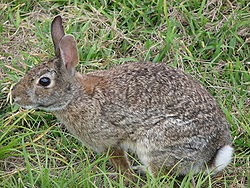
Leporidae
Leporids are the approximately 50 species of rabbits and hares which form the family Leporidae. The leporids, together with the pikas, constitute the mammalian order Lagomorpha. Leporids differ from pikas in having short furry tails, and elongated ears and hind legs...
(hare
Hare
Hares and jackrabbits are leporids belonging to the genus Lepus. Hares less than one year old are called leverets. Four species commonly known as types of hare are classified outside of Lepus: the hispid hare , and three species known as red rock hares .Hares are very fast-moving...
s and rabbit
Rabbit
Rabbits are small mammals in the family Leporidae of the order Lagomorpha, found in several parts of the world...
s), and Ochotonidae (pika
Pika
The pika is a small mammal, with short limbs, rounded ears, and short tail. The name pika is used for any member of the Ochotonidae, a family within the order of lagomorphs, which also includes the Leporidae . One genus, Ochotona, is recognised within the family, and it includes 30 species...
s). Though they can resemble rodent
Rodent
Rodentia is an order of mammals also known as rodents, characterised by two continuously growing incisors in the upper and lower jaws which must be kept short by gnawing....
s, and were classified as a superfamily
Taxonomic rank
In biological classification, rank is the level in a taxonomic hierarchy. Examples of taxonomic ranks are species, genus, family, and class. Each rank subsumes under it a number of less general categories...
in that order until the early 20th century, they have since been considered a separate order. They differ from rodents in a number of physical characteristics, such as having four incisors in the upper jaw rather than two. Central America's lagomorph diversity is considerably less than that of Mexico as a whole, but is greater than that of South America.
- Family: LeporidaeLeporidaeLeporids are the approximately 50 species of rabbits and hares which form the family Leporidae. The leporids, together with the pikas, constitute the mammalian order Lagomorpha. Leporids differ from pikas in having short furry tails, and elongated ears and hind legs...
(rabbits, hares)-
- Genus: Sylvilagus
- TapetiTapetiThe Tapeti , also known as the Brazilian Rabbit or Forest Rabbit, is a cottontail rabbit species found in Central and South America....
Sylvilagus brasiliensis LC - Dice's CottontailDice's CottontailDice's Cottontail is a species of mammal in the Leporidae family. It is found in Costa Rica and Panama, in páramo and cloud forest habitats....
Sylvilagus dicei DD - Eastern CottontailEastern CottontailThe eastern cottontail is a New World cottontail rabbit, a member of the family Leporidae. It is one of the most common rabbit species in North America.-Distribution:...
Sylvilagus floridanus LC
- Tapeti
- Genus: LepusHareHares and jackrabbits are leporids belonging to the genus Lepus. Hares less than one year old are called leverets. Four species commonly known as types of hare are classified outside of Lepus: the hispid hare , and three species known as red rock hares .Hares are very fast-moving...
- Tehuantepec JackrabbitTehuantepec JackrabbitThe Tehuantepec Jackrabbit is easily distinguished from other species of jackrabbits by two black stripes that run from the base of the ears to the nape, and by its white flanks. Underparts are white, upperparts are bright-brown washed with black, rump is gray, and the tail is black. This leporid...
Lepus flavigularis EN
- Tehuantepec Jackrabbit
- Genus: Sylvilagus
-
Order: Eulipotyphla (shrews, hedgehogs, moles, and solenodons)
----
The "shrew-forms" are insectivorous mammals. Shrews and solenodons closely resemble mice, hedgehog
Hedgehog
A hedgehog is any of the spiny mammals of the subfamily Erinaceinae and the order Erinaceomorpha. There are 17 species of hedgehog in five genera, found through parts of Europe, Asia, Africa, and New Zealand . There are no hedgehogs native to Australia, and no living species native to the Americas...
s carry spines, while mole
Mole (animal)
Moles are small cylindrical mammals adapted to a subterranean lifestyle. They have velvety fur; tiny or invisible ears and eyes; and short, powerful limbs with large paws oriented for digging. The term is especially and most properly used for the true moles, those of the Talpidae family in the...
s are stout-bodied burrowers. Central America's shrew diversity is comparable to that of Mexico as a whole, and is greater than that of South America. Moles are not found in the Americas
Americas
The Americas, or America , are lands in the Western hemisphere, also known as the New World. In English, the plural form the Americas is often used to refer to the landmasses of North America and South America with their associated islands and regions, while the singular form America is primarily...
south of northern Mexico
Mexico
The United Mexican States , commonly known as Mexico , is a federal constitutional republic in North America. It is bordered on the north by the United States; on the south and west by the Pacific Ocean; on the southeast by Guatemala, Belize, and the Caribbean Sea; and on the east by the Gulf of...
.
- Family: Soricidae (shrews)
- Subfamily: Soricinae
- Genus: Cryptotis
- C. mexicana group
- Mexican Small-eared ShrewMexican Small-eared ShrewThe Mexican Small-eared Shrew is a species of mammal in the family Soricidae. It is endemic to Mexico....
Cryptotis mexicana LC - goldmani set
- Goldman's Broad-clawed ShrewGoldman's Broad-clawed ShrewGoldman's Broad-clawed Shrew is a species of mammal in the Soricidae family. It is found in Guatemala and Mexico.-References:* Insectivore Specialist Group 1996. . Downloaded on 30 July 2007....
Cryptotis goldmani LC - Goodwin's Broad-clawed ShrewGoodwin's Broad-clawed ShrewGoodwin's Broad-clawed Shrew is a species of mammal in the Soricidae family. It is found in El Salvador, Guatemala, and Mexico.Type locality "Calel, altitude 10200 feet, Guatemala."-References:...
Cryptotis goodwini LC - Guatemalan Broad-clawed ShrewGuatemalan broad-clawed shrewThe Guatemalan broad-clawed shrew is a species of mammal in the family Soricidae. It is known from Guatemala and the Mexican state of Chiapas, where it has been found in montane forests of oak, pine and fir, as well as secondary forest, mostly at elevations above 2000 m. It feeds on insects....
Cryptotis griseoventris VU - Cryptotis lacertosus
- Cryptotis mam
- Goldman's Broad-clawed Shrew
- Mexican Small-eared Shrew
- C. nigrescens group
- Honduran Small-eared ShrewHonduran Small-eared ShrewThe Honduran Small-eared Shrew is a species of mammal in the Soricidae family. It is found in Honduras, possibly El Salvador, possibly Guatemala, and possibly Nicaragua.-Source:...
Cryptotis hondurensis DD - Yucatan Small-eared ShrewYucatan small-eared shrewThe Yucatan small-eared shrew is a species of mammal in the family Soricidae. It is mainly known from lowlands of Guatemala, Belize and Mexico's Yucatán Peninsula, where it has been found in dry scrubland and tropical dry forest at elevations below 100 m. It is threatened by deforestation....
Cryptotis mayensis LC - Darién Small-eared ShrewDarién small-eared shrewThe Darién small-eared shrew is a species of mammal in the family Soricidae. It is known only from montane regions along the border between Colombia and Darién Province, Panama, where it has been found in rainforest at elevations from 1400 to 1500 m. It has terrestrial habits....
Cryptotis mera EN - Merriam's Small-eared Shrew Cryptotis merriami LC
- Blackish Small-eared ShrewBlackish Small-eared ShrewThe Blackish Small-eared Shrew is a species of mammal in the Soricidae family. It is found in parts of Costa Rica, El Salvador, Guatemala, Honduras, Mexico, and Panama. An example specific habitat is the Petenes mangroves of the Yucatan.-References:* Insectivore Specialist Group 1996. . ...
Cryptotis nigrescens LC
- Honduran Small-eared Shrew
- C. parva group
- Central American Least ShrewCentral American Least ShrewThe Central American Least Shrew is a species of mammal in the family Soricidae. It is found in the highlands and mid-elevations from the western part of the northern coast of Honduras to central Costa Rica. It is found in El Salvador, Honduras, Nicaragua, and Costa Rica. It was considered to be a...
Cryptotis orophila DD - North American Least Shrew Cryptotis parva LC
- Tropical Small-eared ShrewTropical Small-eared ShrewThe Tropical Small-eared Shrew is a very small mammal of the Soricidae family. The species is found in the eastern highlands of Chiapas, Mexico, and parts of Belize and Guatemala. Until recently it was considered a subspecies of the North American Least Shrew but it has gained species status...
Cryptotis tropicalis DD
- Central American Least Shrew
- ungrouped/relict
- Enders's Small-eared ShrewEnders's Small-eared ShrewEnders's Small-eared Shrew is a species of mammal in the Soricidae family. It is endemic to Panama.-Source:* Baillie, J. 1996. . Downloaded on 30 July 2007....
Cryptotis endersi EN - Talamancan Small-eared ShrewTalamancan Small-eared ShrewThe Talamancan Small-eared Shrew is a species of mammal in the Soricidae family. It is found in Costa Rica and Panama.-Source:* Baillie, J. 1996. . Downloaded on 30 July 2007....
Cryptotis gracilis VU
- Enders's Small-eared Shrew
- C. mexicana group
- Genus: SorexSorexThe genus Sorex includes many of the common shrews of Eurasia and North America. Members of this genus, known as long-tailed shrews, are the only members of the tribe Soricini of the subfamily Soricinae...
- Subgenus Otisorex
- Verapaz ShrewVerapaz ShrewThe Verapaz Shrew is a species of mammal in the Soricidae family. It is found in Guatemala and Mexico.-References:* Insectivore Specialist Group 1996. . Downloaded on 30 July 2007....
Sorex veraepacis LC
- Verapaz Shrew
- Subgenus Incertae sedisIncertae sedis, is a term used to define a taxonomic group where its broader relationships are unknown or undefined. Uncertainty at specific taxonomic levels is attributed by , , and similar terms.-Examples:*The fossil plant Paradinandra suecica could not be assigned to any...
- Saussure's ShrewSaussure's ShrewSaussure's Shrew is a species of mammal in the Soricidae family. It is found in Guatemala and Mexico.-References:* Insectivore Specialist Group 1996. . Downloaded on 30 July 2007....
Sorex saussurei LC - Sclater's ShrewSclater's ShrewSclater's Shrew is a species of mammal in the family Soricidae. It is endemic to Mexico.-Source:* Cuarón, A.D. & de Grammont, P.C. 2008. . Downloaded on 25 February 2009....
Sorex sclateri CR - San Cristobal ShrewSan Cristobal ShrewThe San Cristobal Shrew is a species of mammal in the Soricidae family. It is endemic to Mexico.-Source:* Cuarón, A.D., de Grammont, P.C., Matson, J. & Woodman, N. 2008. . Downloaded on 25 February 2009....
Sorex stizodon CR - Veracruz ShrewVeracruz ShrewThe Veracruz Shrew is a species of mammal in the family Soricidae. It is found in Mexico....
Sorex veraecrucis LC
- Saussure's Shrew
- Subgenus Otisorex
- Genus: Cryptotis
- Subfamily: Soricinae
Order: Chiroptera (bats)
----
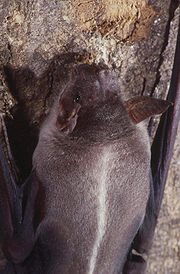
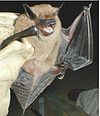
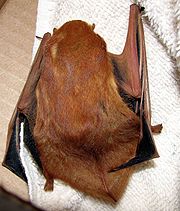

- Family: Noctilionidae
-
- Genus: Noctilio
- Lesser Bulldog BatLesser Bulldog BatThe Lesser Bulldog Bat is an insectivorous and occasionally carnivorous bat of the , ranging through Central America and northern South America....
Noctilio albiventris LC - Greater Bulldog BatGreater Bulldog BatThe greater bulldog bat or fisherman bat is a type of fishing bat native to Latin America. The bat uses echolocation to detect water ripples made by the fish upon which it preys, then uses the pouch between its legs to scoop the fish up and its sharp claws to catch and cling to it...
Noctilio leporinus LC
- Lesser Bulldog Bat
- Genus: Noctilio
-
- Family: Vespertilionidae
- Subfamily: Myotinae
- Genus: Myotis
- Silver-tipped MyotisSilver-tipped MyotisThe Silver-tipped Myotis is a species of mouse-eared bat found in a range of lowland habitats in the Americas.It is part of the Myotis genus of vesper bats, which includes a large number of common species across the world...
Myotis albescens LC - Southwestern MyotisSouthwestern MyotisThe Southwestern Myotis is a species of vesper bat in the Vespertilionidae family.It is found in Guatemala, Mexico, and in Arizona and New Mexico in the United States....
Myotis auriculus LC - California MyotisCalifornia MyotisThe California Myotis is a species of vesper bat in the Vespertilionidae family.It is found in British Columbia in Canada, Guatemala, Mexico, and in the western United States, including California....
Myotis californicus LC - Guatemalan MyotisGuatemalan MyotisThe Guatemalan Myotis is a species of vesper bat in the Vespertilionidae family.It is found only in Guatemala.-Source:* Cajas, J. & Miller, B. 2008. . Downloaded on 28 February 2009....
Myotis cobanensis DD - Elegant MyotisElegant MyotisThe Elegant Myotis is a species of vesper bat in the Vespertilionidae family.It is found in Belize, Costa Rica, El Salvador, Guatemala, Honduras, Mexico, and Nicaragua.-Source:...
Myotis elegans LC - Cinnamon MyotisCinnamon MyotisThe Cinnamon Myotis is a species of vesper bat in the Vespertilionidae family.It is found in Guatemala and Mexico.-Source:* Perez, S., de Grammont, P.C. & Cuarón, A.D. 2008. . Downloaded on 28 February 2009....
Myotis fortidens LC - Hairy-legged MyotisHairy-legged MyotisThe Hairy-Legged Myotis is a species of vesper bat in the Vespertilionidae family.It can be found in the following countries: Argentina, Belize, Bolivia, Colombia, Costa Rica, Ecuador, El Salvador, Guatemala, Honduras, Mexico, Nicaragua, Panama, Peru, Trinidad and Tobago, and...
Myotis keaysi LC - Black MyotisBlack MyotisThe Black Myotis , is a bat species from South and Central America.Its body is dark brown/black. The head to body length, not including the tail, is about 5cm . The Black Myotis is a tiny bat with a small pointed non-noseleaf snout. Its ears are pointy and triangular, and extremely sensitive...
Myotis nigricans LC - Montane MyotisMontane MyotisThe Montane Myotis is a species of vesper bat in the Vespertilionidae family.It is found in Bolivia, Colombia, Costa Rica, Ecuador, Panama, and Venezuela.-References:...
Myotis oxyotus LC - Riparian MyotisRiparian MyotisThe Riparian Myotis , is a bat species from South and Central America....
Myotis riparius LC - Fringed MyotisFringed MyotisThe Fringed Myotis is a species of vesper bat in the Vespertilionidae family.It is found in British Columbia in Canada, Mexico, and the western United States....
Myotis thysanodes LC - Cave MyotisCave MyotisThe Cave Myotis is a species of vesper bat in the Vespertilionidae family.It is found in Belize, El Salvador, Guatemala, Honduras, Mexico and in the southwest United States....
Myotis velifer LC
- Silver-tipped Myotis
- Genus: Myotis
- Subfamily: VespertilioninaeVespertilioninaeVespertilioninae is a subfamily of Vesper Bats from the family Vespertilionidae.-Classification:Subfamily Vespertilioninae*Tribe Eptesicini**Genus Arielulus***Collared Pipistrelle, Arielulus aureocollaris...
- Genus: Bauerus
- Van Gelder's BatVan Gelder's BatVan Gelder's Bat is a species of vesper bat in the Vespertilionidae family.It is found in Belize, Costa Rica, Honduras, and Mexico. It is monotypic within its genus...
Bauerus dubiaquercus NT
- Van Gelder's Bat
- Genus: EptesicusEptesicusEptesicus is a genus of bats, commonly called house bats, in the family Vespertilionidae.The 25 species within this genus are:*Little black serotine *Bobrinski's Serotine...
- Little Black Serotine Eptesicus andinus LC
- Brazilian Brown BatBrazilian Brown BatThe Brazilian Brown Bat, Eptesicus brasiliensis, is a bat species from South and Central America....
Eptesicus brasiliensis LC - Chiriquinan Serotine Eptesicus chiriquinus LC
- Argentine Brown BatArgentine Brown BatThe Argentine Brown Bat , is a bat species from South and Central America....
Eptesicus furinalis LC - Big brown batBig brown batThe Big Brown Bat is larger in size than comparative species of bats, from about 4 to 5 inches in body length, with a 11-13 inch wingspan and weighing 1/2 to 5/8 ounce. The fur is moderately long, and shiny brown...
Eptesicus fuscus LC
- Genus: LasiurusLasiurusLasiurus is the genus comprising hairy-tailed bats. The name Lasiurus is derived from the Greek lasios and oura . It contains some of the most attractive bats in the whole continent of North America including such species as the red bat, L. borealis, and the hoary bat, L. cinereus...
- Desert red batDesert red batThe desert red bat, also known as the Western Red Bat, is one of many species of bats. This particular one is from the Vespertilionidae family which is the largest family. It includes 35 genera and 318 species...
Lasiurus blossevillii LC - Tacarcuna BatTacarcuna BatThe Tacarcuna Bat is a species of vesper bat in the Vespertilionidae family.It is found in Costa Rica, Panama and possibly Colombia.-References:...
Lasiurus castaneus DD - Hoary batHoary batThe hoary bat is a species of bat in the vesper bat family, Vespertilionidae. It occurs throughout most of North America and much of South America, with disjunct populations in the Galapagos and Hawaiian Islands...
Lasiurus cinereus LC - Southern Yellow BatSouthern Yellow BatThe Southern Yellow Bat , is a species of bat in the vesper bat family, Vespertilionidae. It is native to South, North and Central America, from the Rio Grande Valley of Texas in the United States to Argentina. This species roosts in trees and vegetation...
Lasiurus ega LC - Big Red BatBig Red BatThe Big Red Bat , is a bat species from South, North and Central America. It is found in Brazil and Panama....
Lasiurus egregius DD - Northern Yellow BatNorthern Yellow BatThe Northern Yellow Bat is a species of vesper bat in the family Vespertilionidae. It can be found in the following countries: Belize, Costa Rica, Cuba, El Salvador, Guatemala, Honduras, Mexico, and United States....
Lasiurus intermedius LC
- Desert red bat
- Genus: PipistrellusPipistrellusPipistrellus is a genus of bats in the family Vespertilionidae and subfamily Vespertilioninae. The name of the genus is derived from the Italian word Pipistrello, meaning "bat"....
- Eastern PipistrelleEastern PipistrelleThe Tricolored Bat is a species of bat that is widely distributed throughout the eastern parts of North America, ranging west until Kansas and Texas, from Honduras up north until southern Ontario...
Pipistrellus subflavus LC
- Eastern Pipistrelle
- Genus: PlecotusPlecotusThe genus Plecotus consists of the lump-nosed bats. Many species in the genus have only been described and recognized in recent years.-Species:Genus Plecotus - Lump-nosed bats*Plecotus ariel*Brown Long-eared Bat, Plecotus auritus...
- Mexican Big-eared BatMexican Big-eared BatThe Mexican Big-Eared Bat is a species of vesper bat in the Vespertilionidae family.It is found only in Mexico and Arizona.-References:* Arroyo-Cabrales, J. & Reid, F. 2008. . Downloaded on 03 March 2009....
Plecotus mexicanus NT
- Mexican Big-eared Bat
- Genus: RhogeessaRhogeessaRhogeessa is a genus of bats within the "Vesper bats" family, Vespertilionidae. Species within this genus are:*Yucatan Yellow Bat *Allen's Yellow Bat *Genoways's Yellow Bat...
- Yucatan Yellow BatYucatan Yellow BatThe Yucatan Yellow Bat, Rhogeessa aeneus, is a species of bat found in the Yucatán Peninsula in Mexico, and possibly also in Belize and Guatemala....
Rhogeessa aeneus LC - Genoways's Yellow BatGenoways's Yellow BatGenoways's Yellow Bat is a species of vesper bat in the Vespertilionidae family.It is found only in Mexico.It is threatened by habitat loss.-Source:...
Rhogeessa genowaysi EN - Slender Yellow BatSlender Yellow BatThe Slender Yellow Bat is a species of vesper bat in the Vespertilionidae family.It is found only in Mexico.-Source:* Arroyo-Cabrales, J. & Ticul Alvarez Castaneda, S. 2008. . Downloaded on 03 March 2009....
Rhogeessa gracilis LC - Thomas's Yellow Bat Rhogeessa io LC
- Little Yellow BatLittle Yellow BatThe Little Yellow Bat is a species of vesper bat in the Vespertilionidae family.It is found only in Mexico.-Source:* Arroyo-Cabrales, J. & Ticul Alvarez Castaneda, S. 2008. . Downloaded on 3 March 2009....
Rhogeessa parvula LC - Black-winged Little Yellow BatBlack-winged Little Yellow BatThe Black-winged Little Yellow Bat , is a Central American bat species found from Mexico to Costa Rica.-References:* Chiroptera Specialist Group 1996. . Downloaded on 26 October 2008.*...
Rhogeessa tumida LC
- Yucatan Yellow Bat
- Genus: Bauerus
- Subfamily: Myotinae

- Family: Molossidae
-
- Genus: CynomopsCynomopsCynomops is a genus of Central and South American bats in the family Molossidae. It has sometimes been considered a subgenus of Molossops...
- Mexican Dog-faced BatMexican dog-faced batThe Mexican dog-faced bat is a bat species from Central America. It is found from Nayarit in Mexico to Costa Rica at elevations up to 1500 m. It was formerly considered a subspecies of C. greenhalli. It roosts in deciduous and evergreen forest, and is usually found near small bodies of water....
Cynomops mexicanus LC - Southern Dog-faced BatSouthern Dog-faced BatThe Southern Dog-faced Bat , is a bat species from South and Central America....
Cynomops planirostris LC
- Mexican Dog-faced Bat
- Genus: EumopsEumopsEumops is a genus of bats in the family Molossidae.-Reference:* Baker, R.J.; McDonough, M.M.; Swier, V.J.; Larsen, P.A.; Carrera, J.P.; Ammerman, L.K. 2009. New species of bonneted bat, genus Eumops from the lowlands of western Ecuador and Peru. Acta Chiropterologica 11 : 1-13....
- Black Bonneted BatBlack Bonneted BatThe Black Bonneted Bat , is a bat species from South and Central America.-References:* Barquez, R., Rodriguez, B., Miller, B. & Diaz, M. 2008. . Downloaded on 3 March 2009.*...
Eumops auripendulus LC - Dwarf Bonneted BatDwarf Bonneted BatThe Dwarf Bonneted Bat , is a bat species from South and Central America.-References:* Chiroptera Specialist Group 1996. . Downloaded on 26 October 2008.*...
Eumops bonariensis LC - Wagner's Bonneted BatWagner's Bonneted BatWagner's Bonneted Bat , is a species of bat in the family Molossidae. it is found in the Americas from Argentina and Peru north to Mexico, Cuba and Florida in the United States....
Eumops glaucinus LC - Sanborn's Bonneted BatSanborn's Bonneted BatSanborn's Bonneted Bat , is a bat species from South and Central America.-References:* Chiroptera Specialist Group 1996. . Downloaded on 26 October 2008*...
Eumops hansae LC - Underwood's Bonneted BatUnderwood's Bonneted BatUnderwood's Bonneted Bat is a species of bat in the family Molossidae. It is found in Belize, Costa Rica, El Salvador, Guatemala, Honduras, Mexico, Nicaragua and the United States....
Eumops underwoodi LC
- Black Bonneted Bat
- Genus: MolossusMolossus (genus)Molossus is a genus of bats. The genus contains ten species with a New World distribution from Mexico in the north to northern Argentina at its most southerly limit...
- Black Mastiff BatBlack Mastiff BatThe Black Mastiff Bat , is a bat species from South and Central America.-References:* Barquez, R., Rodriguez, B., Miller, B. & Diaz, M. 2008. . Downloaded on 03 March 2009.*-External links:*...
Molossus ater LC - Aztec Mastiff BatAztec mastiff batThe Aztec mastiff bat is a species of bat in the family Molossidae. It is found in Mexico, Guatemala, Honduras and Nicaragua in a variety of forest habitats at elevations from near sea level to 1300 m....
Molossus aztecus LC - Bonda Mastiff BatBonda Mastiff BatThe Bonda Mastiff Bat or Thomas's mastiff bat , is a bat species from South and Central America.-References:* Chiroptera Specialist Group 1996. . Downloaded on 26 October 2008.*...
Molossus currentium LC - Coiban Mastiff BatCoiban mastiff batThe Coiban mastiff bat is a species of bat in the family Molossidae. It is found in Brazil, Peru, Ecuador, Venezuela, Panama, Costa Rica, El Salvador and Mexico in a variety of forest habitats at elevations from near sea level to 1300 m....
Molossus coibensis LC - Velvety Free-tailed BatVelvety Free-tailed BatThe Velvety Free-tailed Bat or Pallas's Mastiff Bat , is a bat species in the family Molossidae. It occurs in the Americas from Argentina north to Cuba and Mexico and also the Florida Keys in the United States....
Molossus molossus LC - Miller's Mastiff BatMiller's Mastiff BatMiller's Mastiff Bat is a species of bat in the family Molossidae. It is found in Colombia, Costa Rica, Guyana, Mexico, Nicaragua, Trinidad and Tobago, and Venezuela.-References:...
Molossus pretiosus LC - Sinaloan Mastiff BatSinaloan Mastiff BatThe Sinaloan Mastiff Bat is a species of bat in the family Molossidae. It is found in Belize, Colombia, Costa Rica, El Salvador, Guatemala, Guyana, Honduras, Mexico, Nicaragua, Panama, Suriname, Trinidad and Tobago, and Venezuela....
Molossus sinaloae LC
- Black Mastiff Bat
- Genus: NyctinomopsNyctinomopsNyctinomops is a genus of bats in the family Molossidae....
- Peale's Free-tailed BatPeale's Free-tailed BatPeale's Free-tailed Bat is a bat species from South and Central America.-References:* Chiroptera Specialist Group 1996. . Downloaded on 26 October 2008.*...
Nyctinomops aurispinosus LC - Broad-eared BatBroad-eared BatThe Broad-eared Bat , is a bat species from South and Central America.-References:* Chiroptera Specialist Group 1996. . Downloaded on 26 October 2008.*-External links:...
Nyctinomops laticaudatus LC - Big Free-tailed BatBig Free-tailed BatThe Big Free-tailed Bat is a bat species found in South, North and Central America. They have a wingspan of 435 mm and an average length of 140 mm. This bat frequents rocky or canyon country where it roosts in crevices. This migratory species is a swift, powerful flier, and occasional individuals...
Nyctinomops macrotis LC
- Peale's Free-tailed Bat
- Genus: PromopsPromopsPromops is a genus of molossid bats.-Species:Promops is a genus of molossid bats.-Species:Promops is a genus of molossid bats.-Species::Promops centralis - big crested mastiff bat:Promops nasutus - brown mastiff bat...
- Big Crested Mastiff BatBig Crested Mastiff BatThe Big Crested Mastiff Bat , is a bat species from South and Central America.-References:* Chiroptera Specialist Group 1996. . Downloaded on 26 October 2008.*...
Promops centralis LC
- Big Crested Mastiff Bat
- Genus: TadaridaTadaridaThe genus Tadarida has ten or more species of bats divided into two subgenera, with the first of these containing seven species spread across the Old World...
- Mexican Free-tailed BatMexican Free-tailed BatThe Mexican free-tailed bat , also known as the Brazilian free-tailed bat, is a medium-sized bat that is native to the Americas and is widely regarded as one of the most abundant mammals in North America...
Tadarida brasiliensis LC
- Mexican Free-tailed Bat
- Genus: Cynomops
-
- Family: Emballonuridae
-
- Genus: BalantiopteryxBalantiopteryxBalantiopteryx is a genus of sac-winged bats. It comprises three species:*Balantiopteryx infusca *Balantiopteryx io *Balantiopteryx plicata -External links:*...
- Thomas's Sac-winged BatThomas's Sac-Winged BatThomas's Sac-winged Bat is a species of sac-winged bat in the family Emballonuridae.It is found in Belize, Guatemala, and Mexico.-References:* Chiroptera Specialist Group 1996. . Downloaded on 19 July 2007....
Balantiopteryx io VU - Gray Sac-winged BatGray Sac-Winged BatThe Gray Sac-winged Bat is a species of sac-winged bat in the family Emballonuridae. It is found in Mexico from Baja California Sur and Sonora to Guatemala, El Salvador, Honduras, Nicaragua, Costa Rica and northern Colombia, at elevations up to 1500 m....
Balantiopteryx plicata LC
- Thomas's Sac-winged Bat
- Genus: Cormura
- Chestnut Sac-Winged BatChestnut Sac-Winged BatThe Chestnut Sac-winged Bat or Wagner's Sac-winged Bat is a species of sac-winged bat . It is found in Brazil, Colombia, Costa Rica, Ecuador, French Guiana, Guyana, Nicaragua, Panama, Peru, Suriname, and Venezuela. Its natural habitat is subtropical or tropical moist lowland forests...
Cormura brevirostris LC
- Chestnut Sac-Winged Bat
- Genus: Cyttarops
- Short-eared BatShort-eared BatThe Short-eared Bat, Cyttarops alecto, is a bat species from South and Central America. It is found in Brazil, Costa Rica, Guyana and Nicaragua. It is monotypic within its genus.-References:...
Cyttarops alecto LC
- Short-eared Bat
- Genus: DiclidurusDiclidurusDiclidurus is a genus of bats whose common name is the ghost bats. They all inhabit South America and sometimes also Central America....
- Northern Ghost BatNorthern Ghost BatThe Northern Ghost Bat or Jumby Bat, Diclidurus albus, is a bat species from South America, Trinidad, and Central America. It is a relatively rare, completely white, insectivorous bat, with an unusual sac at the base of its tail. Specimens have been found infected with rabies in...
Diclidurus albus LC
- Northern Ghost Bat
- Genus: PeropteryxPeropteryxPeropteryx is a genus of 5 species of bat in the family Emballonuridae, namely:*Greater Dog-like Bat *White-winged Dog-like Bat *Lesser Dog-like Bat...
- Greater Dog-like BatGreater Dog-like BatThe Greater Dog-like Bat, Peropteryx kappleri, is a bat species from Central America and South America. It is found from southern Mexico through Brazil and Peru.The Greater Dog-like Bat is so named due to its remarkably dog-like characteristics....
Peropteryx kappleri LC - Lesser Doglike BatLesser Doglike BatThe Lesser Dog-like Bat, Peropteryx macrotis, is a bat species from South and Central America.-References:* Chiroptera Specialist Group 1996. . Downloaded on 26 October 2008.*...
Peropteryx macrotis LC
- Greater Dog-like Bat
- Genus: Rhynchonycteris
- Proboscis BatProboscis BatThe proboscis bat, Rhynchonycteris naso, is a bat species from South and Central America. Other common names include sharp-nosed bat, Brazilian long-nosed bat and river bat in English, and murciélago narizón in Spanish. It is monotypic within its genus.This species is in the family Emballonuridae,...
Rhynchonycteris naso LC
- Proboscis Bat
- Genus: SaccopteryxSaccopteryxSaccopteryx is a genus of sac-winged bats from Central and South America. The species within this genus are:*Antioquian Sac-winged Bat Saccopteryx antioquensis*Greater Sac-winged Bat Saccopteryx bilineata...
- Greater Sac-winged BatGreater Sac-winged BatThe Greater Sac-winged Bat, Saccopteryx bilineata, is a bat of the family Emballonuridae native to Middle and South America.They are the most common bats seen in the rainforest as they often roost on the outside of large trees. They are insectivores and use echolocation calls through the mouth to...
Saccopteryx bilineata LC - Lesser Sac-winged BatLesser Sac-winged BatThe Lesser Sac-winged Bat is a bat species of the family Emballonuridae from South and Middle America.-References:*...
Saccopteryx leptura LC
- Greater Sac-winged Bat
- Genus: Balantiopteryx
-
- Family: MormoopidaeMormoopidaeThe family Mormoopidae contains bats known generally as mustached bats, ghost-faced bats, and naked-backed bats. They are found in the Americas from the Southwestern United States to Southeastern Brazil....
-
- Genus: MormoopsMormoopsMormoops is a genus of bat in the family Mormoopidae.It contains the following species:* Antillean Ghost-faced Bat * Giant Ghost-faced Bat * Ghost-faced Bat...
- Ghost-faced BatGhost-faced BatThe Ghost-faced Bat is a bat in the genus Mormoops. It occurs in Belize, Colombia, Ecuador, El Salvador, Guatemala, Honduras, Mexico. Peru, Trinidad and Tobago, Venezuela and in Texas in the United States. Mormoops megalophylla is one of only two extant species within it genus, the other being...
Mormoops megalophylla LC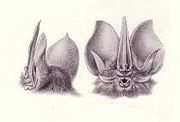
- Ghost-faced Bat
- Genus: PteronotusPteronotusPteronotus is a genus of bats. Seven extant species have been recognized, as well as one relatively recently extinct species-References:...
- Davy's Naked-backed BatDavy's Naked-backed BatDavy's Naked-backed Bat, Pteronotus davyi, is a small insect-eating, cave-dwelling bat and is found throughout South and Central America, including Trinidad, but not Tobago. Its wings are attached to the top of its body instead of to the sides, as in all other bat species. Specimens of this bat...
Pteronotus davyi LC - Big Naked-backed BatBig Naked-backed BatThe Big Naked-backed Bat, Pteronotus gymnonotus, is a bat species from South and Central America.-References:*...
Pteronotus gymnonotus LC - Parnell's Mustached BatParnell's Mustached BatParnell's Mustached Bat, Pteronotus parnellii is an insectivorous bat native to North, Central and South America. This bat species ranges from southern Sonora, Mexico south to Brazil. Historically, it had a wider range as fossil specimens have been collected on the island of New Providence,...
Pteronotus parnellii LC - Wagner's Mustached BatWagner's Mustached BatWagner's Mustached Bat, Pteronotus personatus, is a bat species from South and Central America. It is one of the few New World bats species known to perform Doppler-shift compensation behavior.-Description:...
Pteronotus personatus LC
- Davy's Naked-backed Bat
- Genus: Mormoops
-
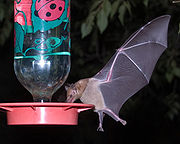
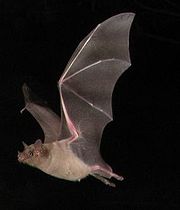
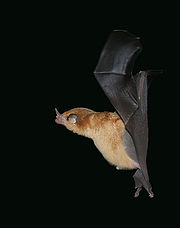


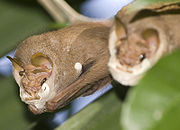

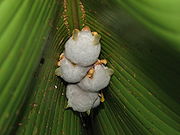

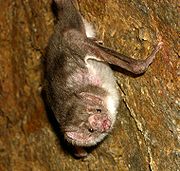
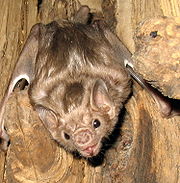
- Family: Phyllostomidae
- Subfamily: PhyllostominaePhyllostominaePhyllostominae is a subfamily of bats.-List of species:Subfamily Phyllostominae* Tribe Micronycterini**Genus: Glyphonycteris***Behn's Bat, Glyphonycteris behnii***Davies's Big-eared Bat, Glyphonycteris daviesi...
- Genus: Chrotopterus
- Big-eared Wooly BatBig-eared Wooly BatThe Big-eared Woolly Bat , Chrotopterus auritus, is a bat species native to Central and South America, where it is found from southern Mexico to northern Argentina, Paraguay and southern Brazil...
Chrotopterus auritus LC
- Big-eared Wooly Bat
- Genus: GlyphonycterisGlyphonycterisGlyphonycteris is a genus of bat in the family Phyllostomidae.It contains the following species:* Behn's Bat * Davies's Big-eared Bat * Tricolored Big-eared Bat...
- Davies's Big-eared BatDavies's Big-eared BatDavies's Big-eared Bat or the Graybeard Bat is a species of bat in the family Phyllostomidae. It is found in Brazil, Colombia, Costa Rica, Ecuador, French Guiana, Guyana, Honduras, Panama, Peru, Suriname, Trinidad and Tobago, and Venezuela.-Source:* Ochoa, J. & Velazco, P. 2008. . Downloaded...
Glyphonycteris daviesi LC - Tricolored Big-eared BatTricolored Big-eared BatThe Tricolored Big-eared Bat, Glyphonycteris sylvestris, is a bat species from South and Central America.-References:* Zortea, M., Sampaio, E., Lim, B., Peters, S. & Arroyo-Cabrales, J. 2008. . Downloaded on 04 March 2009.*...
Glyphonycteris sylvestris LC
- Davies's Big-eared Bat
- Genus: Lampronycteris
- Yellow-throated Big-eared BatYellow-throated Big-eared BatThe Yellow-throated Big-eared Bat, Lampronycteris brachyotis , is a species of bat from South and Central America, where it ranges from southern Mexico to Brazil. It is monotypic within the genus Lampronycteris....
Lampronycteris brachyotis LC
- Yellow-throated Big-eared Bat
- Genus: LonchorhinaLonchorhinaLonchorhina is a genus of Central and South American bats in the family Phyllostomidae.-Species:Genus Lonchorhina - Sword-nosed Bats*Tomes's Sword-nosed Bat, Lonchorhina aurita - Tomes, 1863...
- Tomes's Sword-nosed BatTomes's Sword-nosed BatTomes's Sword-nosed Bat, Lonchorhina aurita, is a bat species from South and Central America. Also found in the Bahamas, known only from one specimen collected on the island of New Providence.-References:...
Lonchorhina aurita LC
- Tomes's Sword-nosed Bat
- Genus: LophostomaLophostomaLophostoma is a genus of Central and South American bats in the family Phyllostomidae.-Species:Genus Lophostoma*Equatorial Round-eared Bat, Lophostoma aequatorialis*Pygmy Round-eared Bat, Lophostoma brasiliense...
- Pygmy Round-eared BatPygmy Round-eared BatThe Pygmy Round-eared Bat, Lophostoma brasiliense, is a bat species from South and Central America.-References:* Chiroptera Specialist Group 1996. . Downloaded on 26 October 2008.*...
Lophostoma brasiliense LC - Davis's Round-eared BatDavis's Round-eared BatDavis's Round-eared Bat is a species of Central American bat in the family Phyllostomidae . It is found in Belize, Guatemala, Honduras, and southeastern Mexico.-Source:...
Lophostoma evotis LC - White-throated Round-eared BatWhite-throated Round-eared BatThe White-throated Round-eared Bat, Lophostoma silvicolum, is a South and Central American bat species, found from Honduras to Bolivia, Paraguay and Brazil. It creates roosts inside the nests of the termite, Nasutitermes corniger....
Lophostoma silvicolum LC
- Pygmy Round-eared Bat
- Genus: Macrophyllum
- Long-legged BatLong-legged BatThe Long-legged Bat, Macrophyllum macrophyllum, is a bat species from South and Central America. It is monotypic in its genus.It hunts close over the water surfaces of lakes and slowly flowing streams, where it seizes insects right above or directly off the surface in a manner similar to Noctilio...
Macrophyllum macrophyllum LC
- Long-legged Bat
- Genus: MacrotusMacrotusMacrotus is a genus of bats in the Neotropical family Phyllostomidae. This genus contains two species, Macrotus californicus commonly known as California Leaf-nosed Bat and Macrotus waterhousii commonly known as Mexican or Waterhouse's Leaf-nosed Bat...
- Waterhouse's Leaf-nosed BatWaterhouse's Leaf-nosed BatWaterhouse's Leaf-nosed Bat is a species of bat in the family Phyllostomidae. It is found in Bahamas, Cayman Islands, Cuba, the Dominican Republic, Guatemala, Haiti, Jamaica, Mexico, and Puerto Rico.Waterhousii is also a big eared Bat which has ranges from Sonora to Hidalgo Mexico, south to...
Macrotus waterhousii LC
- Waterhouse's Leaf-nosed Bat
- Genus: MicronycterisMicronycterisMicronycteris is a genus of leaf-nosed bats.-List of species:Genus Micronycteris - Little Big-eared Bats*Brosset's Big-eared Bat, Micronycteris brosseti*Giovanni's Big-eared Bat, Micronycteris giovanniae...
- Hairy Big-eared BatHairy Big-eared BatThe Hairy Big-eared Bat, Micronycteris hirsuta, is a bat species from South and Central America....
Micronycteris hirsuta LC - White-bellied Big-eared BatWhite-bellied Big-eared BatThe White-bellied Big-eared Bat, Micronycteris minuta, is a bat species from South and Central America....
Micronycteris minuta LC - Schmidts's Big-eared BatSchmidts's Big-eared BatSchmidts's Big-eared Bat, Micronycteris schmidtorum, is a bat species from South and Central America.-References:* Chiroptera Specialist Group 1996. . Downloaded on 26 October 2008.*...
Micronycteris schmidtorum LC
- Hairy Big-eared Bat
- Genus: MimonMimonMimoň is a town in the Czech Republic.- People :* Rudolf Watzke , bass singer* Rudolf Schicketanz , Nazi politician* Hans Watzek , poltician...
- Cozumelan Golden Bat Mimon cozumelae LC
- Striped Hairy-nosed BatStriped Hairy-nosed BatThe Striped Hairy-nosed Bat, Mimon crenulatum, is a bat species from South and Central America. It is found in Brazil, Colombia, Ecuador, French Guiana, Guyana, Suriname and Venezuela.-References:...
Mimon crenulatum LC
- Genus: Phylloderma
- Pale-faced BatPale-faced BatThe Pale-faced Bat, Phylloderma stenops, is a bat species from South and Central America.-References:* Chiroptera Specialist Group 1996. . Downloaded on 26 October 2008.*...
Phylloderma stenops LC
- Pale-faced Bat
- Genus: PhyllostomusPhyllostomusPhyllostomus is a genus of leaf-nosed bat. It contains four described species.-Species:Genus Phyllostomus - Spear-nosed Bats*Pale Spear-nosed Bat, Phyllostomus discolor*Lesser Spear-nosed Bat, Phyllostomus elongatus...
- Pale Spear-nosed BatPale Spear-nosed BatThe Pale Spear-nosed Bat, Phyllostomus discolor, is a bat species from South and Central America. It ranges from southern Mexico to Peru, Bolivia, Paraguay, northern Argentina and southeast Brazil.It eats flowers and fruit as well as insects...
Phyllostomus discolor LC - Greater Spear-nosed BatGreater Spear-nosed BatThe Greater Spear-nosed Bat, Phyllostomus hastatus, is a bat species of the family Phyllostomidae from South and Central America. It is one of the larger bats of this region, and is omnivorous.- Habitat :...
Phyllostomus hastatus LC
- Pale Spear-nosed Bat
- Genus: TonatiaTonatiaTonatia is a genus of South and Central American phyllostomid bats.-Species:Tonatia is a genus of South and Central American phyllostomid bats.-Species:Tonatia is a genus of South and Central American phyllostomid bats....
- Stripe-headed Round-eared BatStripe-headed Round-eared BatThe Stripe-headed Round-eared Bat, Tonatia saurophila, is a bat species from South and Central America.-References:* Chiroptera Specialist Group 1996. . Downloaded on 26 October 2008.*...
Tonatia saurophila LC
- Stripe-headed Round-eared Bat
- Genus: Trachops
- Fringe-lipped BatFringe-lipped BatOnThe Fringe-lipped Bat , also known as the Frog-eating Bat, is a leaf-nosed bat. It has three subspecies currently known today. It ranges from southern Mexico to Bolivia and southern Brazil. The species is monotypic within its genus.-Description:The fringe-lipped bat has a total length of 7.84 mm...
Trachops cirrhosus LC
- Fringe-lipped Bat
- Genus: Trinycteris
- Niceforo's Big-eared BatNiceforo's Big-eared BatNiceforo's Big-eared Bat, Trinycteris nicefori, is a bat species from South and Central America. It is monotypic within its genus....
Trinycteris nicefori LC
- Niceforo's Big-eared Bat
- Genus: Vampyrum
- Spectral BatSpectral BatThe Spectral Bat is a large, carnivorous leaf-nosed bat. Some alternate names for this species are the False Vampire Bat, Linnaeus's False Vampire Bat and the Spectral Vampire Bat...
Vampyrum spectrum NT
- Spectral Bat
- Genus: Chrotopterus
- Subfamily: GlossophaginaeGlossophaginaeGlossophaginae is a subfamily of leaf-nosed bats.-List of species:Subfamily: Glossophaginae* Tribe Glossophagini**Genus: Anoura - Geoffroy's Long-nosed Bats***Anoura aequatoris***Cadena's Tailless Bat, Anoura cadenai...
- Genus: AnouraAnouraAnoura is a genus of leaf-nosed bats from Central and South America.-Species:*Anoura aequatoris*Cadena's Tailless Bat, Anoura cadenai*Anoura canishina*Tailed Tailless Bat, Anoura caudifer*Handley's Tailless Bat, Anoura cultrata...
- Handley's Tailless BatHandley's Tailless BatHandley's Tailless Bat is a species of bat in the family Phyllostomidae. It is found in Bolivia, Colombia, Costa Rica, Ecuador, Panama, Peru, and Venezuela....
Anoura cultrata NT - Geoffroy's Tailless BatGeoffroy's Tailless BatGeoffroy's Tailless Bat , is a bat species from South and Central America, where it is found from central Mexico to Bolivia and southeastern Brazil.-Habitat:...
Anoura geoffroyi LC
- Handley's Tailless Bat
- Genus: ChoeroniscusChoeroniscusChoeroniscus is a genus of bat in the family Phyllostomidae.It contains the following species:* Godman's Long-tailed Bat * Greater Long-tailed Bat...
- Godman's Long-tailed BatGodman's Long-tailed BatGodman's Long-tailed Bat is a species of bat in the family Phyllostomidae. It is found in Colombia, Costa Rica, El Salvador, Guatemala, Guyana, Honduras, Mexico, Nicaragua, Suriname, and Venezuela.-Source:...
Choeroniscus godmani LC
- Godman's Long-tailed Bat
- Genus: Choeronycteris
- Mexican Long-tongued BatMexican Long-tongued BatThe Mexican Long-tongued Bat is a species of bat in the family Phyllostomidae. It is monotypic within the genus Choeronycteris. The species is found in El Salvador, Guatemala, Honduras, Mexico, and the United States.Mexican long-tongued bats feed on nectar and pollen from agaves and other plants...
Choeronycteris mexicana NT
- Mexican Long-tongued Bat
- Genus: GlossophagaGlossophagaGlossophaga is a genus of bats in the leaf-nosed bat family, Phyllostomidae. Members of the genus are native to the American Neotropics.-Species:*G. commissarisi : Commissaris's Long-tongued Bat - Central and South America...
- Commissaris's Long-tongued BatCommissaris's Long-tongued BatCommissaris's Long-tongued Bat, Glossophaga commissarisi, is a bat species from South and Central America.-References:* Chiroptera Specialist Group 1996. . Downloaded on 26 October 2008.*...
Glossophaga commissarisi LC - Gray Long-tongued BatGray Long-tongued BatThe Gray Long-tongued Bat is a species of bat in the family Phyllostomidae. It is found in Costa Rica, El Salvador, Guatemala, Honduras, Mexico, and Nicaragua.-References:...
Glossophaga leachii LC - Western Long-tongued BatWestern Long-tongued BatThe Western Long-tongued Bat is a species of bat in the family Phyllostomidae. It is endemic to Mexico.-Source:...
Glossophaga morenoi LC - Pallas's Long-tongued BatPallas's Long-tongued BatPallas's Long-tongued Bat, Glossophaga soricina, is a South and Central American bat. It has the fastest metabolism ever recorded in a mammal, similar to those of hummingbirds...
Glossophaga soricina LC
- Commissaris's Long-tongued Bat
- Genus: Hylonycteris
- Underwood's Long-tongued BatUnderwood's Long-tongued BatUnderwood's Long-tongued Bat is a species of bat in the family Phyllostomidae. It is monotypic within the genus Hylonycteris. It is found in Belize, Guatemala, Mexico, Nicaragua, and Panama.-References:...
Hylonycteris underwoodi LC
- Underwood's Long-tongued Bat
- Genus: Leptonycteris
- Southern Long-nosed BatSouthern Long-nosed BatThe Southern Long-nosed Bat is a species of bat in the family Phyllostomidae. It is found in Aruba, Colombia, Venezuela, and the Netherlands Antilles. Its roosts in caves and mines, but only breeds in specific caves on islands....
Leptonycteris curasoae VU - Greater Long-nosed BatGreater Long-nosed BatThe Greater Long-nosed Bat or Mexican Long-nosed Bat is a species of bat in the family Phyllostomidae. It is found in Mexico, the United States, and in Guatemala. Its natural habitat is temperate forests. It is threatened by habitat loss...
Leptonycteris nivalis EN
- Southern Long-nosed Bat
- Genus: Lichonycteris
- Dark Long-tongued BatDark Long-tongued BatThe Dark Long-tongued Bat, Lichonycteris obscura, is a bat species from South and Central America. It is monotypic within its genus.-References:* Chiroptera Specialist Group 1996. . Downloaded on 26 October 2008.*...
Lichonycteris obscura LC
- Dark Long-tongued Bat
- Genus: Lionycteris
- Chestnut Long-tongued BatChestnut Long-tongued BatThe Chestnut Long-tongued Bat, Lionycteris spurrelli, is a bat species from South and Central America. It is monotypic within its genus....
Lionycteris spurrelli LC
- Chestnut Long-tongued Bat
- Genus: LonchophyllaLonchophyllaLonchophylla is a genus of bats in the family Phyllostomidae.-List of species:Genus Lonchophylla*Bokermann's Nectar Bat, Lonchophylla bokermanni*Cadena's Long-tongued Bat, Lonchophylla cadenai...
- Lonchophylla concava NT
- Godman's Nectar BatGodman's Nectar BatGodman's Nectar Bat, Lonchophylla mordax, is a bat species from South and Central America. It is found in Brazil, Colombia, Costa Rica, Ecuador and Panama....
Lonchophylla mordax LC - Orange Nectar BatOrange Nectar BatThe Orange Nectar Bat is a species of bat in the family Phyllostomidae. It is found in Colombia, Costa Rica, Ecuador, Nicaragua, Panama, Peru, and Venezuela.-References:...
Lonchophylla robusta LC - Thomas's Nectar BatThomas's Nectar BatThomas's Nectar Bat, Lonchophylla thomasi, is a bat species from South and Central America....
Lonchophylla thomasi LC
- Genus: Anoura
- Subfamily: CarolliinaeCarolliinaeCarolliinae is a subfamily of bats.-Classification:Subfamily Carolliinae*Genus: Carollia - Short-tailed Leaf-nosed Bats**Benkeith's short-tailed Bat, Carollia benkeithi**Silky Short-tailed Bat, Carollia brevicauda...
- Genus: CarolliaCarolliaCarollia is a genus of bats often referred to as the short-tailed fruit bats. Along with the genus, Rhinophylla, Carollia makes up the subfamily Carolliinae of family Phyllostomidae, the leaf-nosed bats. Currently, nine species of Carollia are recognized, with a number having been described since...
- Silky Short-tailed BatSilky Short-tailed BatThe Silky Short-tailed Bat, Carollia brevicauda, is a bat species from South and Central America. It is found in Bolivia, Brazil, Colombia, Ecuador, French Guiana, Guyana, Panama, Peru, Suriname, Mexico and Venezuela.-References:...
Carollia brevicauda LC - Chestnut Short-tailed BatChestnut Short-tailed BatThe Chestnut Short-tailed Bat, Carollia castanea, is a bat species from South and Central America....
Carollia castanea LC - Seba's Short-tailed BatSeba's Short-tailed BatSeba's Short-tailed Bat, Carollia perspicillata, is a common and widespread bat species from South and Central America.C. perspicillata dwells in both moist evergreen and dry deciduous forests, usually below 1,000 meters altitude, typically roosting in groups of 10-100 bats in caves, hollow trees,...
Carollia perspicillata LC - Sowell's Short-tailed BatSowell's short-tailed batSowell's short-tailed bat, Carollia sowelli, is a common bat species in the family Phyllostomidae. It is found from San Luis Potosi through Central America to west Panama. The species is named after American philanthropist James N. Sowell....
Carollia sowelli LC - Gray Short-tailed BatGray Short-tailed BatThe Gray Short-tailed Bat is a species of bat in the family Phyllostomidae. It is found in El Salvador, Guatemala, Honduras, Mexico, and Nicaragua.-References:...
Carollia subrufa LC
- Silky Short-tailed Bat
- Genus: Carollia
- Subfamily: StenodermatinaeStenodermatinaeStenodermatinae is a large subfamily of bats in the family Phyllostomidae.-List of species:Subfamily Stenodermatinae*Genus: Ametrida**Little White-shouldered Bat, Ametrida centurio*Genus: Ardops**Tree Bat, Ardops nichollsi...
- Genus: Ametrida
- Little White-shouldered BatLittle White-shouldered BatThe Little White-shouldered Bat, Ametrida centurio, is a bat species from South and Central America. It is monotypic within its genus.-References:*...
Ametrida centurio LC
- Little White-shouldered Bat
- Genus: ArtibeusArtibeusThe Neotropical fruit bats are a genus of bats within the subfamily Stenodermatinae. The genus consists of 21 species, which are native to Central and South America, as well as parts of the Caribbean.-Description:...
- Aztec Fruit-eating BatAztec Fruit-eating BatThe Aztec Fruit-eating Bat is a species of bat in the family Phyllostomidae. It is found in Costa Rica, El Salvador, Guatemala, Honduras, Mexico, and Panama.-References:...
Artibeus aztecus LC - Solitary Fruit-eating BatSolitary fruit-eating batThe solitary fruit-eating bat, Artibeus incomitatus, is a species of bat in the family Phyllostomidae. It is endemic to a small island off the Caribbean coast of Panama, Isla Escudo de Veraguas, and is considered to be critically endangered. The species is frugivorous....
Artibeus incomitatus CR - Honduran Fruit-eating BatHonduran Fruit-eating BatThe Honduran Fruit-eating Bat is a species of bat in the family Phyllostomidae. It is found in El Salvador, Honduras, and Nicaragua.-References:* Reid, F. & Medina, A. 2008. . Downloaded on 28 February 2009....
Artibeus inopinatus DD - Jamaican fruit batJamaican fruit batThe Jamaican, Common or Mexican fruit bat is a fruit bat native to Central and South America, as well as the Greater and many of the Lesser Antilles. It is also an uncommon resident of the Southern Bahamas...
Artibeus jamaicensis LC - Great Fruit-eating BatGreat Fruit-eating BatThe Great Fruit-eating Bat , is a bat species in the family Phyllostomidae from South and Central America. It is found from Mexico to Brazil and Argentina, as well as in Barbados, Grenada, Martinique, Saint Lucia, Saint Vincent and the Grenadines and Trinidad and Tobago.They are 10.5 g at birth and...
Artibeus lituratus LC - Pygmy Fruit-eating BatPygmy Fruit-eating BatThe pygmy fruit-eating bat, Artibeus phaeotis, is a bat of the family Phyllostomidae. The specific name phaeotis is of Greek derivation, coming from the word phaios meaning dusky, referring to their dusky gray coloration.-Biogeography:...
Artibeus phaeotis LC - Toltec Fruit-eating BatToltec Fruit-eating BatThe Toltec Fruit-eating Bat is a species of bat in the family Phyllostomidae. It is found in Belize, Colombia, Costa Rica, Ecuador, El Salvador, Guatemala, Honduras, Mexico, Nicaragua, and Panama.-References:...
Artibeus toltecus LC
- Aztec Fruit-eating Bat
- Genus: CenturioWrinkle-faced BatThe Wrinkle-faced Bat is a species of bat in the family Phyllostomidae. It is the only identified member of the genus Centurio. It is found in various countries in and around Central America. It eats fruit but is not classified within the fruit bats. It is classified as a leaf-nosed bat but does...
- Wrinkle-faced BatWrinkle-faced BatThe Wrinkle-faced Bat is a species of bat in the family Phyllostomidae. It is the only identified member of the genus Centurio. It is found in various countries in and around Central America. It eats fruit but is not classified within the fruit bats. It is classified as a leaf-nosed bat but does...
Centurio senex LC
- Wrinkle-faced Bat
- Genus: ChirodermaChirodermaChiroderma is a genus of leaf-nosed bat found in Central America, South America and the Lesser Antilles.-Species:Genus Chiroderma - Big-eyed Bats or White-lined Bats*Brazilian Big-eyed Bat, Chiroderma doriae...
- Salvin's Big-eyed BatSalvin's Big-eyed BatSalvin's Big-eyed Bat is a species of bat in the family Phyllostomidae. It is found in Bolivia, Colombia, Costa Rica, Ecuador, El Salvador, Guatemala, Honduras, Mexico, Panama, Peru, and Venezuela.-References:...
Chiroderma salvini LC - Little Big-eyed BatLittle Big-eyed BatThe Little Big-eyed Bat, Chiroderma trinitatum, is a bat species from South and Central America....
Chiroderma trinitatum LC - Hairy Big-eyed BatHairy Big-eyed BatThe Hairy Big-eyed Bat, Chiroderma villosum, is a bat species from South and Central America.-References:* Chiroptera Specialist Group 1996. . Downloaded on 26 October 2008.*...
Chiroderma villosum LC
- Salvin's Big-eyed Bat
- Genus: Ectophylla
- Honduran white batHonduran white batThe Honduran white bat has snow white fur and a yellow nose and ears. It is tiny, only 3.7-4.7cm long. The only member of the genus Ectophylla, it is found in Honduras, Nicaragua, Costa Rica and western Panama at elevations from sea level to 700 m...
Ectophylla alba NT
- Honduran white bat
- Genus: Enchisthenes
- Velvety Fruit-eating BatVelvety Fruit-eating BatThe Velvety Fruit-eating Bat is a species of bat in the family Phyllostomidae. It is monotypic within the genus Enchisthenes. It is found in Bolivia, Colombia, Costa Rica, Ecuador, El Salvador, Guatemala, Honduras, Mexico, Panama, Peru, the United States, and Venezuela....
Enchisthenes hartii LC
- Velvety Fruit-eating Bat
- Genus: Mesophylla
- MacConnell's BatMacConnell's BatMacConnell's Bat, Mesophylla macconnelli, is a bat species from South and Central America. It is monotypic within its genus....
Mesophylla macconnelli LC
- MacConnell's Bat
- Genus: PlatyrrhinusPlatyrrhinusPlatyrrhinus is a genus of leaf-nosed bats.-Species:Genus Platyrrhinus*Alberico's Broad-nosed Bat, Platyrrhinus albericoi*Platyrrhinus angustirostris*Platyrrhinus aquilus...
- Thomas's Broad-nosed BatThomas's Broad-nosed BatThomas's Broad-nosed Bat is a species of bat in the family Phyllostomidae. It is found in Bolivia, Colombia, Ecuador, Panama, and Peru.-References:* Chiroptera Specialist Group 1996. . Downloaded on 30 July 2007....
Platyrrhinus dorsalis LC - Heller's Broad-nosed BatHeller's Broad-nosed BatHeller's Broad-nosed Bat, Platyrrhinus helleri, is a bat species from South and Central America.-References:* Miller, B., Reid, F., Arroyo-Cabrales, J., Cuarón, A.D. & de Grammont, P.C. 2008. . Downloaded on 28 February 2009.*...
Platyrrhinus helleri LC - Greater Broad-nosed BatGreater Broad-nosed BatThe Greater Broad-nosed Bat is a species of bat in the family Phyllostomidae. It is found in Bolivia, Colombia, Costa Rica, Ecuador, Panama, Peru, and Venezuela.-References:...
Platyrrhinus vittatus LC
- Thomas's Broad-nosed Bat
- Genus: SturniraSturniraSturnira is a genus of bat in the family Phyllostomidae.It contains the following species:* Aratathomas's Yellow-shouldered Bat, Sturnira aratathomasi* Bidentate Yellow-shouldered Bat, Sturnira bidens...
- Little Yellow-shouldered BatLittle Yellow-shouldered BatThe Little Yellow-shouldered Bat, Sturnira lilium, is a bat species from South and Central America. The Little Yellow-shouldered Bat is a frugivor.-References:* Chiroptera Specialist Group 1996. . Downloaded on 26 October 2008.*...
Sturnira lilium LC - Highland Yellow-shouldered BatHighland Yellow-shouldered BatThe Highland Yellow-shouldered Bat is a species of bat in the family Phyllostomidae. It is found in Colombia, Costa Rica, Ecuador, El Salvador, Guatemala, Guyana, Honduras, Mexico, Nicaragua, Panama, and Venezuela.-References:...
Sturnira ludovici LC - Louis's Yellow-shouldered BatLouis's Yellow-shouldered BatLouis's Yellow-shouldered Bat is a species of bat in the family Phyllostomidae. It is found in Colombia, Costa Rica, Ecuador, Panama, and Peru.-References:* Chiroptera Specialist Group 1996. . Downloaded on 30 July 2007....
Sturnira luisi LC - Talamancan Yellow-shouldered BatTalamancan Yellow-shouldered BatThe Talamancan Yellow-shouldered Bat is a species of bat in the family Phyllostomidae. It is found in Colombia, Costa Rica, and Panama.-Source:* Chiroptera Specialist Group 1996. . Downloaded on 30 July 2007....
Sturnira mordax NT
- Little Yellow-shouldered Bat
- Genus: UrodermaUrodermaUroderma is a genus of Central and South American phyllostomid bats.-Species:Uroderma is a genus of Central and South American phyllostomid bats.-Species:Uroderma is a genus of Central and South American phyllostomid bats....
- Tent-making BatTent-making BatThe Tent-making Bat, Uroderma bilobatum, is a bat species from South and Central America. It lives in hollowed out trees. It is sometimes speculated that the bat is green in color, even though it is only thought so because of the "tent" the bat makes is made out a leaf that is green in color, in...
Uroderma bilobatum LC - Brown Tent-making BatBrown Tent-making BatThe Brown Tent-making Bat, Uroderma magnirostrum, is a bat species from South and Central America.-References:* Chiroptera Specialist Group 1996. . Downloaded on 26 October 2008.*...
Uroderma magnirostrum LC
- Tent-making Bat
- Genus: VampyressaVampyressaVampyressa is a genus of bat in the family Phyllostomidae.It contains the following species:* Bidentate Yellow-eared Bat * Brock's Yellow-eared Bat * Melissa's Yellow-eared Bat...
- Striped Yellow-eared BatStriped Yellow-eared BatThe Striped Yellow-eared Bat is a species of bat in the family Phyllostomidae. It is found in Colombia, Costa Rica, Ecuador, Nicaragua, and Panama.-References:...
Vampyressa nymphaea LC
- Striped Yellow-eared Bat
- Genus: Vampyrodes
- Great Stripe-faced BatGreat Stripe-faced BatThe Great Stripe-faced Bat, Vampyrodes caraccioli, is a bat species from South and Central America, where it is found from southern Mexico to Bolivia and northwestern Brazil, as well as on Trinidad. The Great Stripe-faced Bat is a frugivore. It is monotypic within its genus....
Vampyrodes caraccioli LC
- Great Stripe-faced Bat
- Genus: Ametrida
- Subfamily: Desmodontinae
- Genus: DesmodusDesmodusDesmodus is a genus of bats often referred to as the vampire bats. Along with the genera, Diaemus and Diphylla, Desmodus makes up the subfamily Desmodontinae of family Phyllostomidae, the vampire bats.Genus Desmodus - vampire bats...
- Common Vampire BatCommon Vampire BatThe Common Vampire Bat is a small leaf-nosed bat native to the Americas. It is one of three extant species of vampire bat, the other two being the Hairy-legged Vampire Bat and the White-winged Vampire Bat. Along with them, it is the only parasitic mammal. It mainly feeds on the blood of livestock...
Desmodus rotundus LC
- Common Vampire Bat
- Genus: Diaemus
- White-winged Vampire BatWhite-winged Vampire BatThe White-winged Vampire Bat is a species of vampire bat. It is the only member of the genus Diaemus. It is found from Mexico to southern Argentina and is present on the islands of Trinidad and Isla Margarita...
Diaemus youngi LC
- White-winged Vampire Bat
- Genus: Diphylla
- Hairy-legged Vampire BatHairy-legged Vampire BatThe Hairy-legged Vampire Bat is one of three species of vampire bat. Despite connotations of vampires, it mainly feeds on the blood of birds. This vampire bat lives mainly in tropical and subtropical forestlands of South America...
Diphylla ecaudata LC
- Hairy-legged Vampire Bat
- Genus: Desmodus
- Subfamily: Phyllostominae
- Family: NatalidaeNatalidaeThe family Natalidae, or funnel-eared bats are found from Mexico to Brazil and the Caribbean islands. The family has three genera, Chilonatalus, Natalus and Nyctiellus. They are slender bats with unusually long tails and, as their name suggests, funnel-shaped ears. They are small, at only 3.5 to...
(funnel-eared bats)-
- Genus: NatalusNatalusThe genus Natalus of funnel-eared bats is found from Mexico to Brazil and the Caribbean islands. They are slender bats with unusually long tails and, as their name suggests, funnel-shaped ears. They are small, at only 3.5 to 5.5 cm in length, with brown, grey, or reddish fur...
- Mexican Greater Funnel-eared Bat Natalus mexicanus LC
- Genus: Natalus
-
- Family: FuripteridaeFuripteridaeFuripteridae is one of the families of bats. This family contains only two species, the Smokey Bat and the Thumbless Bat. Both are from Central and South America, and are closely related to the bats in the Natalidae and Thyropteridae families. They can be recognized by their reduced and...
-
- Genus: Furipterus
- Thumbless BatThumbless BatThe Thumbless Bat is a species of bat in the Furipteridae family, in the monotypic genus Furipterus. It is found in Costa Rica, Brazil, Venezuela; Colombia; Ecuador; Suriname; French Guiana; Guyana; Panama; Trinidad, and Peru. They have a small thumb which is included in the membrane of the wing,...
Furipterus horrens LC
- Thumbless Bat
- Genus: Furipterus
-
- Family: ThyropteridaeThyropteridaeDisc-winged bats are a small group of bats of the family Thyropteridae. They are found in Central and South America, usually in moist tropical rain forests. It is a very small family, consisting of a single genus with four species....
-
- Genus: Thyroptera
- Peter's Disk-winged BatPeter's Disk-winged BatPeter's Disk-winged Bat, Thyroptera discifera, is a bat species from South and Central America.-External links:*...
Thyroptera discifera LC - Spix's Disk-winged BatSpix's Disk-winged BatSpix's Disk-winged Bat, Thyroptera tricolor, is a bat species from South and Central America. It ranges from south Mexico to Bolivia.-References:* Chiroptera Specialist Group 1996. . Downloaded on 26 October 2008.*...
Thyroptera tricolor LC
- Peter's Disk-winged Bat
- Genus: Thyroptera
-
Order: CarnivoraCarnivoraThe diverse order Carnivora |Latin]] carō "flesh", + vorāre "to devour") includes over 260 species of placental mammals. Its members are formally referred to as carnivorans, while the word "carnivore" can refer to any meat-eating animal...
(carnivorans)
----
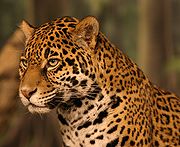
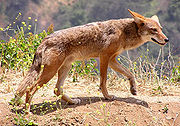
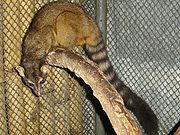

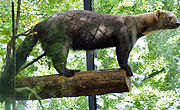
- Suborder: FeliformiaFeliformiaThe Feliformia are a suborder within the order Carnivora and includes cats , hyenas, mongooses, civets and related taxa. The other suborder of Carnivora is Caniformia...
- Family: FelidaeFelidaeFelidae is the biological family of the cats; a member of this family is called a felid. Felids are the strictest carnivores of the thirteen terrestrial families in the order Carnivora, although the three families of marine mammals comprising the superfamily pinnipedia are as carnivorous as the...
(cats)- Subfamily: FelinaeFelinaeFelinae is a subfamily of the family Felidae which includes the genera and species listed below. Most are small to medium-sized cats, although the group does include some larger animals, such as the Cougar and Cheetah....
- Genus: LeopardusLeopardusLeopardus is a genus consisting of small spotted cats mostly native to Middle and South America. Very few range into the southern United States. The genus is considered the oldest branch of the part of the cat family to cross into the Americas, followed by the genera Lynx and Puma...
- OcelotOcelotThe ocelot , pronounced /ˈɒsəˌlɒt/, also known as the dwarf leopard or McKenney's wildcat is a wild cat distributed over South and Central America and Mexico, but has been reported as far north as Texas and in Trinidad, in the Caribbean...
Leopardus pardalis LC - Oncilla Leopardus tigrinus VU
- MargayMargayThe Margay is a spotted cat native to Middle and South America. Named for Prince Maximilian of Wied-Neuwied, it is a solitary and nocturnal animal that prefers remote sections of the rainforest. Although it was once believed to be vulnerable to extinction, the IUCN now lists it as "Near Threatened"...
Leopardus wiedii NT
- Ocelot
- Genus: PumaPuma (genus)Puma is a genus in Felidae that contains the cougar and the jaguarundi, and may also include several poorly known Old World fossil representatives .-Species:*Puma concolor – CougarPuma pardoides Puma is a genus in Felidae that contains the cougar (also known as the puma, among other names)...
- Cougar Puma concolor LC
- JaguarundiJaguarundiThe jaguarundi is a small-sized wild cat native to Central and South America. In 2002, the IUCN classified the jaguarundi as Least Concern as it is likely that no conservation units, with the probable exception of the mega-reserves of the Amazon basin could sustain long-term viable populations. It...
Puma yagouaroundi LC
- Genus: Leopardus
- Subfamily: PantherinaePantherinaePantherinae is the subfamily of the family Felidae, which includes the genera Panthera, Uncia and Neofelis.The divergence of Pantherinae from Felinae has been ranked between six and ten million years ago. DNA analysis suggests that the snow leopard Uncia uncia is basal to the entire Pantherinae and...
- Genus: PantheraPantheraPanthera is a genus of the family Felidae , which contains four well-known living species: the tiger, the lion, the jaguar, and the leopard. The genus comprises about half of the Pantherinae subfamily, the big cats...
- JaguarJaguarThe jaguar is a big cat, a feline in the Panthera genus, and is the only Panthera species found in the Americas. The jaguar is the third-largest feline after the tiger and the lion, and the largest in the Western Hemisphere. The jaguar's present range extends from Southern United States and Mexico...
Panthera onca NT
- Jaguar
- Genus: Panthera
- Subfamily: Felinae
- Family: Felidae
- Suborder: CaniformiaCaniformiaCaniformia, or Canoidea , is a suborder within the order Carnivora. They typically possess a long snout and non-retractile claws . The Pinnipedia evolved from caniform ancestors and are accordingly assigned to this group...
- Family: CanidaeCanidaeCanidae is the biological family of carnivorous and omnivorous mammals that includes wolves, foxes, jackals, coyotes, and domestic dogs. A member of this family is called a canid . The Canidae family is divided into two tribes: Canini and Vulpini...
(dogs, foxes)- Subfamily: CaninaeCaninaeCaninae is the only living subfamily of Canidae. Many extinct species of Caninae were endemic to North America, living from 34 Ma—11,000 years ago. Some members of the endemic North American canines survived to the present time. This subfamily was recently revised by Tedford, Wang, and Taylor...
- Genus: UrocyonUrocyonThe genus Urocyon is a genus that contains two living Western Hemisphere foxes in the family Canidae, the Gray Fox and the closely related Island Fox which is a dwarf cousin of the Gray Fox; as well as one fossil species, Urocyon progressus.Urocyon and the...
- Gray FoxGray FoxThe gray fox is a mammal of the order Carnivora ranging throughout most of the southern half of North America from southern Canada to the northern part of South America...
Urocyon cinereoargenteus LC - Cozumel FoxCozumel FoxThe Cozumel Fox is an undescribed species of fox which is apparently close to extinction or even already extinct. It is found on the island of Cozumel, Mexico. The Cozumel Fox, which has not been scientifically described to date, is a dwarf form like the Island Fox but slightly larger, being up...
Urocyon sp. nov. CR or EX
- Gray Fox
- Genus: SpeothosSpeothosSpeothos is a genus of canid found in Central and South America. The genus includes the living Bush Dog, Speothos venaticus, as well as an extinct Pleistocene species, Speothos pacivorus. Surprisingly, the fossil species was identified and named prior to the discovery of the extant species, with...
- Bush DogBush DogThe bush dog is a canid found in Central and South America, including Panama, Colombia, Venezuela, Bolivia, Peru , Ecuador, the Guianas, Paraguay, northeast Argentina and Brazil...
Speothos venaticus NT
- Bush Dog
- Genus: CanisCanisCanis is a genus containing 7 to 10 extant species, including dogs, wolves, coyotes, and jackals, and many extinct species.-Wolves, dogs and dingos:Wolves, dogs and dingos are subspecies of Canis lupus...
- CoyoteCoyoteThe coyote , also known as the American jackal or the prairie wolf, is a species of canine found throughout North and Central America, ranging from Panama in the south, north through Mexico, the United States and Canada...
Canis latrans LC
- Coyote
- Genus: Urocyon
- Subfamily: Caninae
- Family: Ursidae (bears)
- Subfamily: TremarctinaeTremarctinaeTremarctinae is a term for the subfamily of Ursidae containing one living representative, the Spectacled Bear of South America, and several extinct species from four genera: the Florida spectacled bear , the North American short-faced bears of genera Plionarctos and Arctodus Tremarctinae is a...
- Genus: TremarctosTremarctosTremarctos is a genus of the family Ursidae, subfamily Tremarctinae endemic to Americas from the Pliocene to recent. The northern species, the Florida short-faced bear was extinct 11 000 years ago...
- Spectacled BearSpectacled BearThe spectacled bear , also known as the Andean bear and locally as ukuko, jukumari or ucumari, is the last remaining short-faced bear and the closest living relative to the Florida spectacled bear and short-faced bears of the Middle Pleistocene to Late Pleistocene age.The spectacled bear is a...
Tremarctos ornatus VU
- Spectacled Bear
- Genus: Tremarctos
- Subfamily: Tremarctinae
- Family: ProcyonidaeProcyonidaeProcyonidae is a New World family of the order Carnivora. It includes the raccoons, coatis, kinkajous, olingos, ringtails and cacomistles. Procyonids inhabit a wide range of environments, and are generally omnivorous.-Characteristics:...
(raccoons, coatis and relatives)-
- Genus: BassariscusBassariscusBassariscus is a genus in the family Procyonidae. There are two species in the genus: the ringtail or ring-tailed cat and the cacomistle . Genetic studies have suggested that the closest relatives of Bassariscus are raccoons.The genus was first described by Elliott Coues in 1887...
- RingtailRing-tailed CatThe ringtail is a mammal of the raccoon family , native to arid regions of North America. It is also known as the ringtail cat, ring-tailed cat or miner's cat, and is also sometimes mistakenly called a "civet cat"...
Bassariscus astutus LC - CacomistleCacomistleThe cacomistle is a nocturnal, arboreal and omnivorous member of the carnivoran family Procyonidae. Its preferred habitats are wet, tropical, evergreen woodlands and mountain forests, though seasonally it will range into drier deciduous forests.Nowhere in its range is B. sumichrasti common...
Bassariscus sumichrasti LC
- Ringtail
- Genus: ProcyonProcyon (genus)Procyon is a genus of nocturnal mammals, comprising three species commonly known as raccoons, in the family Procyonidae. The most familiar species, the common raccoon , is often known simply as "the" raccoon, as the two other raccoon species in the genus are native only to the tropics and are...
- Crab-eating RaccoonCrab-eating raccoonThe Crab-eating Raccoon is a species of raccoon native to marshy and jungle areas of Central and South America . It is found from Costa Rica south through most areas of South America east of the Andes down to northern Argentina and Uruguay...
Procyon cancrivorus LC - Common Raccoon Procyon lotor LC
- Cozumel Island Raccoon Procyon pygmaeus CR
- Crab-eating Raccoon
- Genus: NasuaNasuaNasua is a genus within the Raccoon family, Procyonidae. The three species within the genus Nasua are generally referred to as coatis. Two additional species of coatis, commonly known as mountain coatis, are placed in the genus Nasuella...
- White-nosed Coati Nasua narica LC
- Cozumel Island CoatiCozumel Island CoatiThe Cozumel Island Coati is a coati from the Mexican island of Cozumel. It is in the family Procyonidae, which also includes raccoons, olingos, and Kinkajous....
Nasua nelsoni EN (often regarded as a subspecies of N. narica)
- Genus: Bassaricyon
- Bushy-tailed OlingoBushy-tailed OlingoThe bushy-tailed olingo , also known simply as the olingo, is a tree-dwelling member of the family Procyonidae, which also includes raccoons. It was the first species of olingo to be described, and is considered by some authors to be the only genuine olingo species. Its scientific name honors...
Bassaricyon gabbii LC - Harris's OlingoHarris's OlingoHarris's Olingo is a species of olingo from Central America, where it is found in the Cordillera Central of Costa Rica. Because of ongoing taxonomic uncertainty this species is considered to be data deficient....
Bassaricyon lasius DD - Chiriqui OlingoChiriqui OlingoThe Chiriqui Olingo is a species of olingo found in Central America. It is known only from Chiriqui Province in western Panama.- External links :*...
Bassaricyon pauli DD
- Bushy-tailed Olingo
- Genus: Potos
- KinkajouKinkajouThe kinkajou , also known as the honey bear , is a rainforest mammal of the family Procyonidae related to olingos, coatis, raccoons, and the ringtail and cacomistle. It is the only member of the genus Potos. Kinkajous may be mistaken for ferrets or monkeys, but are not closely related...
Potos flavus LC
- Kinkajou
- Genus: Bassariscus
-
- Family: MustelidaeMustelidaeMustelidae , commonly referred to as the weasel family, are a family of carnivorous mammals. Mustelids are diverse and the largest family in the order Carnivora, at least partly because in the past it has been a catch-all category for many early or poorly differentiated taxa...
(weasels, otters)- Subfamily: MustelinaeMustelinaeMustelinae is a polyphyletic subfamily of family Mustelidae and includes wolverines, weasels, ferrets, martens, minks, and similar carnivorous mammals of Order Carnivora.- Extant species of Mustelinae :Subfamily Mustelinae*Genus Arctonyx...
- Genus: Mustela
- Long-tailed WeaselLong-tailed WeaselThe long-tailed weasel , also known as the bridled weasel or big stoat is a species of mustelid distributed from southern Canada throughout all the United States and Mexico, southward through all of Central America and into northern South America.-Evolution:The long-tailed weasel is the product of...
Mustela frenata LC
- Long-tailed Weasel
- Genus: EiraTayraThe tayra , also known as the Tolomuco or Perico ligero in Central America, and San Hol or viejo de monte in the Yucatan Peninsula is an omnivorous animal from the weasel family Mustelidae. It is the only species in the genus Eira...
- TayraTayraThe tayra , also known as the Tolomuco or Perico ligero in Central America, and San Hol or viejo de monte in the Yucatan Peninsula is an omnivorous animal from the weasel family Mustelidae. It is the only species in the genus Eira...
Eira barbara LC
- Tayra
- Genus: GalictisGalictisThe grison, also known as the South American glutton, is a neotropical mustelid of South America. Comprising the genus Galictis, it is divided into two species: the greater grison , which is found widely in South America, through Central America to southern Mexico; and the lesser grison , which is...
- Greater grisonGreater GrisonThe greater grison, Galictis vittata, is an animal belonging to the ferret family Mustelidae from Central and South America, from southern Mexico to Brazil and Bolivia, living in savannas and rainforests, usually seen near rivers and streams....
Galictis vittata LC
- Greater grison
- Genus: Mustela
- Subfamily: Lutrinae
- Genus: LontraLontraLontra is a genus of otters from the American continent.The genus comprises four species:*North American River Otter *Southern River Otter *Neotropical Otter...
- Neotropical Otter Lontra longicaudis DD
- Genus: Lontra
- Subfamily: Mustelinae
- Family: Mephitidae (skunks)
-
- Genus: Spilogale
- Southern Spotted Skunk Spilogale angustifrons LC
- Pygmy Spotted SkunkPygmy Spotted SkunkThe Pygmy Spotted Skunk is a species of mammal in the Mephitidae family. It is endemic to Mexico....
Spilogale pygmaea VU
- Genus: MephitisMephitis (genus)The genus Mephitis is one of several genera of skunks, which has two species and a North American distribution.*Striped Skunk *Hooded Skunk...
- Hooded SkunkHooded SkunkThe hooded skunk is a species of mammal in the family Mephitidae. It can be distinguished from the similar striped skunk by its longer tail and longer, softer coat of fur. A ruff of white fur around its neck gives the animal its common name. It is generally more white dorsally, and black...
Mephitis macroura LC
- Hooded Skunk
- Genus: Conepatus
- American Hog-nosed SkunkAmerican Hog-nosed SkunkThe American hog-nosed skunk is a species of hog-nosed skunk from Central and North America, and is one of the largest skunk in the world, growing to lengths of up to 2.7 feet...
Conepatus leuconotus LC - Striped Hog-nosed SkunkStriped Hog-nosed SkunkThe striped hog-nosed skunk, Conepatus semistriatus, is a skunk species from Central and South America. It lives in a wide range of habitats including dry forest scrub and occasionally, in rainforest....
Conepatus semistriatus LC
- American Hog-nosed Skunk
- Genus: Spilogale
-
- Family: Phocidae (earless seals)
- Subfamily: Monachinae
- Genus: MonachusMonachusMonachus is a genus containing the monk seals, a group of three Pinniped species. They are the only earless seals which are found in tropical climates...
- Caribbean Monk SealCaribbean Monk SealThe Caribbean monk seal or West Indian monk seal is an extinct species of seal. It is the only seal ever known to be native to the Caribbean Sea and the Gulf of Mexico. The last verified recorded sighting occurred in 1952 at Serranilla Bank...
†Monachus tropicalis EX
- Caribbean Monk Seal
- Genus: Monachus
- Subfamily: Monachinae
- Family: Canidae
Order: Perissodactyla (odd-toed ungulates)
----
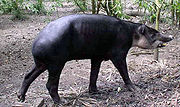
Grazing
Grazing generally describes a type of feeding, in which a herbivore feeds on plants , and also on other multicellular autotrophs...
mammals. They are usually large to very large, and have relatively simple stomachs and a large middle toe. While native equids
Equidae
Equidae is the taxonomic family of horses and related animals, including the extant horses, donkeys, and zebras, and many other species known only from fossils. All extant species are in the genus Equus...
once lived in the region, having evolved in North America over a period of 50 million years
Evolution of the horse
The evolution of the horse pertains to the phylogenetic ancestry of the modern horse from the small dog-sized, forest-dwelling Hyracotherium over geologic time scales...
, they died out around the time of the first arrival of humans.
- Family: Tapiridae (tapirs)
-
- Genus: Tapirus
- Baird's TapirBaird's TapirBaird’s Tapir is a species of tapir that is native to Central America and northern South America. It is one of three Latin American species of tapir.-Names:...
Tapirus bairdii EN
- Baird's Tapir
- Genus: Tapirus
-
Order: Artiodactyla (even-toed ungulates)
----
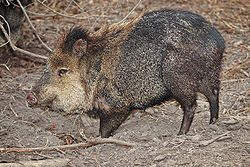
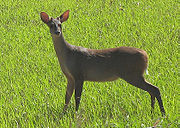
Ungulate
Ungulates are several groups of mammals, most of which use the tips of their toes, usually hoofed, to sustain their whole body weight while moving. They make up several orders of mammals, of which six to eight survive...
s is borne about equally by the third and fourth toes, rather than mostly or entirely by the third as in perissodactyls. There are about 220 artiodactyl species, including many that are of great economic importance to human
Human
Humans are the only living species in the Homo genus...
s. All of Central America's extant ungulates are of Nearctic origin, but prior to the arrival of humans at least one ungulate of South American origin
Mixotoxodon
Mixotoxodon is an extinct genus of notoungulate of the family Toxodontidae which inhabited South America during the Pleistocene living from 1.8—0.30 Ma and existed for approximately ....
also lived in the region.
- Family: Tayassuidae (peccaries)
-
- Genus: PecariPecariPecari is a genus of mammals in the peccary family, Tayassuidae. The genus was monotypic until the description of P. maximus in 2007, but the scientific evidence for its status as a species separate from P...
- Collared PeccaryCollared PeccaryThe collared peccary is a species of mammal in the family Tayassuidae that is found in North, Central, and South America. They are commonly referred to as javelina, saíno or báquiro, although these terms are also used to describe other species in the family...
Pecari tajacu LC
- Collared Peccary
- Genus: Tayassu
- White-lipped PeccaryWhite-lipped PeccaryThe White-lipped Peccary, Tayassu pecari, is a peccary species found in Central and South America, living in rainforest, dry forest and chaco scrub. It is monotypic within the genus Tayassu....
Tayassu pecari NT
- White-lipped Peccary
- Genus: Pecari
-
- Family: Cervidae (deer)
- Subfamily: CapreolinaeCapreolinaeCapreolinae, also known as Odocoileinae or the New World deer , is a subfamily of deer...
- Genus: Mazama
- Amazonian Brown BrocketAmazonian brown brocketThe Amazonian brown brocket , also known as the small brown brocket, is a small species of deer that is almost entirely restricted to South America. It is known from Panama The Amazonian brown brocket (Mazama nemorivaga), also known as the small brown brocket, is a small species of deer that is...
Mazama nemorivaga LC - Yucatan Brown BrocketYucatan Brown BrocketThe Yucatan Brown Brocket is a small species of deer native to the Yucatán Peninsula of Mexico, Belize and Guatemala. While it is found in humid tropical forest like most other brocket deer, the Yucatan Brown Brocket also ranges across arid, relatively open habitats...
Mazama pandora VU - Central American Red BrocketCentral American red brocketThe Central American red brocket, Mazama temama, is a species of brocket deer ranging from southern Mexico, through Central America, to northwestern Colombia. It was formerly treated as a subspecies of the red brocket from South America, but its karyotype has 2n = 50, while the latter's was...
Mazama temama DD
- Amazonian Brown Brocket
- Genus: OdocoileusOdocoileusOdocoileus is a genus of medium-sized deer containing two species native to the Americas. The name is sometimes spelt odocoeleus; it is from a contraction of the roots odonto- and coelus meaning "hollow-tooth".-Species:...
- White-tailed deerWhite-tailed DeerThe white-tailed deer , also known as the Virginia deer or simply as the whitetail, is a medium-sized deer native to the United States , Canada, Mexico, Central America, and South America as far south as Peru...
Odocoileus virginianus LC
- White-tailed deer
- Genus: Mazama
- Subfamily: Capreolinae
Order: CetaceaCetaceaThe order Cetacea includes the marine mammals commonly known as whales, dolphins, and porpoises. Cetus is Latin and is used in biological names to mean "whale"; its original meaning, "large sea animal", was more general. It comes from Ancient Greek , meaning "whale" or "any huge fish or sea...
(whales)
----
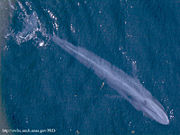

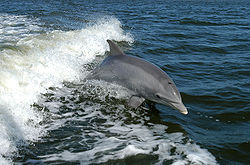



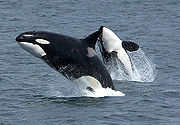

Whale
Whale is the common name for various marine mammals of the order Cetacea. The term whale sometimes refers to all cetaceans, but more often it excludes dolphins and porpoises, which belong to suborder Odontoceti . This suborder also includes the sperm whale, killer whale, pilot whale, and beluga...
s, dolphin
Dolphin
Dolphins are marine mammals that are closely related to whales and porpoises. There are almost forty species of dolphin in 17 genera. They vary in size from and , up to and . They are found worldwide, mostly in the shallower seas of the continental shelves, and are carnivores, mostly eating...
s and porpoise
Porpoise
Porpoises are small cetaceans of the family Phocoenidae; they are related to whales and dolphins. They are distinct from dolphins, although the word "porpoise" has been used to refer to any small dolphin, especially by sailors and fishermen...
s. They are the mammals most fully adapted to aquatic
Aquatic adaptation
Several animal groups have undergone aquatic adaptation, going from being purely terrestrial animals to living at least part of the time in water. The adaptations in early speciation tend to develop as the animal ventures into water in order to find available food. As successive generations spend...
life with a spindle-shaped nearly hairless body, protected by a thick layer of blubber, and forelimbs and tail modified to provide propulsion underwater. Their closest extant relatives are the hippos
Hippopotamidae
Hippopotamuses are the members of the family Hippopotamidae. They are the only extant artiodactyls which walk on four toes on each foot.- Characteristics :...
, which are artiodactyls, from which cetaceans are believed to have descended (as reflected in the naming of the clade
Clade
A clade is a group consisting of a species and all its descendants. In the terms of biological systematics, a clade is a single "branch" on the "tree of life". The idea that such a "natural group" of organisms should be grouped together and given a taxonomic name is central to biological...
Cetartiodactyla
Cetartiodactyla
Cetartiodactyla is the clade in which whales and even-toed ungulates have currently been placed. The term was coined by merging the name for the two orders, Cetacea and Artiodactyla, into a single word. The term Cetartiodactyla reflects the idea that whales evolved within the artiodactyls...
).
- Suborder: Mysticeti
- Family: Balaenopteridae (rorquals)
- Subfamily: Balaenopterinae
- Genus: BalaenopteraBalaenopteraBalaenoptera is a genus of Balaenopteridae, the Rorqual whales, and contains eight species. The species Balaenoptera omurai was published in 2003...
- Bryde's WhaleBryde's WhaleBryde's whales are baleen whales, one of the "great whales" or rorquals. They prefer tropical and temperate waters over the polar seas that other whales in their family frequent. They are largely coastal rather than pelagic. Bryde's whales are very similar in appearance to sei whales and almost as...
Balaenoptera edeni DD - Blue WhaleBlue WhaleThe blue whale is a marine mammal belonging to the suborder of baleen whales . At in length and or more in weight, it is the largest known animal to have ever existed....
Balaenoptera musculus EN - Fin WhaleFin WhaleThe fin whale , also called the finback whale, razorback, or common rorqual, is a marine mammal belonging to the suborder of baleen whales. It is the second longest whale and the sixth largest living animal after the blue whale, bowhead whale, and right whales, growing to nearly 27 metres long...
Balaenoptera physalus EN
- Bryde's Whale
- Genus: Balaenoptera
- Subfamily: Megapterinae
- Genus: Megaptera
- Humpback WhaleHumpback WhaleThe humpback whale is a species of baleen whale. One of the larger rorqual species, adults range in length from and weigh approximately . The humpback has a distinctive body shape, with unusually long pectoral fins and a knobbly head. It is an acrobatic animal, often breaching and slapping the...
Megaptera novaeangliae LC
- Humpback Whale
- Genus: Megaptera
- Subfamily: Balaenopterinae
- Family: Balaenopteridae (rorquals)
- Suborder: Odontoceti
- Superfamily: Platanistoidea
- Family: Physeteridae (sperm whales)
- Genus: Physeter
- Sperm WhaleSperm WhaleThe sperm whale, Physeter macrocephalus, is a marine mammal species, order Cetacea, a toothed whale having the largest brain of any animal. The name comes from the milky-white waxy substance, spermaceti, found in the animal's head. The sperm whale is the only living member of genus Physeter...
Physeter macrocephalus VU
- Sperm Whale
- Genus: Physeter
- Family: Kogiidae (pygmy and dwarf sperm whales)
- Genus: Kogia
- Pygmy Sperm WhalePygmy Sperm WhaleThe Pygmy Sperm Whale is one of three species of toothed whale in the sperm whale family. They are not often sighted at sea, and most of what is known about them comes from the examination of stranded specimens.-Taxonomy:...
Kogia breviceps DD - Dwarf Sperm WhaleDwarf Sperm WhaleThe Dwarf Sperm Whale is one of three species in the sperm whale family. They are not often sighted at sea. As such, most information is a result of the study of stranded carcasses.-Taxonomy:...
Kogia sima DD
- Pygmy Sperm Whale
- Genus: Kogia
- Family: Ziphidae (beaked whales)
- Genus: Ziphius
- Cuvier's Beaked WhaleCuvier's Beaked WhaleCuvier's beaked whale is the most widely distributed of all the beaked whales. It is the only member of the genus Ziphius. Another common name for the species is goose-beaked whale because its head is said to be shaped like the beak of a goose. Georges Cuvier first described it in 1823 from part...
Ziphius cavirostris LC
- Cuvier's Beaked Whale
- Genus: Mesoplodon
- Blainville's Beaked WhaleBlainville's Beaked WhaleBlainville's beaked whale , or the dense-beaked whale, is the widest ranging mesoplodont whale and perhaps the most documented. Henri de Blainville first described the species in 1817 from a small piece of jaw—the heaviest bone he had ever come across—which resulted in the name densirostris...
Mesoplodon densirostris DD - Ginkgo-toothed Beaked WhaleGinkgo-toothed Beaked WhaleThe ginkgo-toothed beaked whale is a poorly known species of whale even for a beaked whale, and was named for the unusual shape of its dual teeth...
Mesoplodon ginkgodens DD - Pygmy Beaked WhalePygmy Beaked WhaleThe pygmy beaked whale , also known as the bandolero beaked whale, Peruvian beaked whale and lesser beaked whale, is the smallest of the mesoplodonts and one of the newest discoveries. There were at least two dozen sightings of an unknown beaked whale named Mesoplodon sp...
Mesoplodon peruvianus DD
- Blainville's Beaked Whale
- Genus: Ziphius
- Family: Delphinidae (marine dolphins)
- Genus: Steno
- Rough-toothed DolphinRough-toothed DolphinThe Rough-toothed dolphin is species of dolphin that can be found in deep warm and tropical waters around the world.The species was first described by Georges Cuvier in 1823...
Steno bredanensis LC
- Rough-toothed Dolphin
- Genus: Sotalia
- CosteroCosteroThe Costero is found in the coastal waters to the north and east of South America. The common name "costero" has been suggested by Caballero and colleagues due to the species' affinity for coastal habitats. The Costero is a member of the oceanic dolphin family . Physically it resembles the...
Sotalia guianensis DD
- Costero
- Genus: Tursiops
- Bottlenose DolphinCommon Bottlenose DolphinTursiops truncatus, commonly known as the Common Bottlenose Dolphin, is the most well-known species from the family Delphinidae.Common bottlenose dolphins are the most familiar dolphins due to the wide exposure they receive in captivity in marine parks, dolphinarias, in movies, and television...
Tursiops truncatus LC
- Bottlenose Dolphin
- Genus: StenellaStenellaStenella is a genus of aquatic mammals in Delphinidae, the family informally known as the oceanic dolphins.Currently five species are recognised in this genus:*Pantropical Spotted Dolphin, S. attenuata*Atlantic Spotted Dolphin, S. frontalis...
- Pantropical Spotted DolphinPantropical Spotted DolphinThe Pantropical Spotted Dolphin is a species of dolphin found in all the world's temperate and tropical oceans. The species was beginning to come under threat due to the killing of millions of individuals in tuna purse seines...
Stenella attenuata LC - Clymene DolphinClymene DolphinThe Clymene dolphin , in older texts known as the Short-snouted spinner dolphin, is a dolphin endemic to the Atlantic Ocean.- Taxonomy :...
Stenella clymene DD - Striped DolphinStriped DolphinThe Striped Dolphin is an extensively studied dolphin that is found in temperate and tropical waters of all the world's oceans.-Taxonomy:...
Stenella coeruleoalba LC - Atlantic Spotted DolphinAtlantic Spotted DolphinThe Atlantic Spotted Dolphin is a dolphin found in the Gulf Stream of the North Atlantic Ocean. Older members of the species have a very distinctive spotted coloration all over their body.-Taxonomy:...
Stenella frontalis DD - Spinner DolphinSpinner DolphinThe Spinner Dolphin is a small dolphin found in off-shore tropical waters around the world. It is famous for its acrobatic displays in which they spin longitudinally along their axis as they leap through the air.-Taxonomy:...
Stenella longirostris DD
- Pantropical Spotted Dolphin
- Genus: DelphinusDelphinusDelphinus is a constellation in the northern sky, close to the celestial equator. Its name is Latin for dolphin. Delphinus was one of the 48 constellations listed by the 2nd century astronomer Ptolemy, and it remains among the 88 modern constellations recognized by the International Astronomical...
- Long-beaked Common DolphinLong-beaked Common DolphinThe Long-beaked Common Dolphin is a species of common dolphin. It has a more restricted range than the Short-beaked Common Dolphin . It has a disjointed range in coastal areas in tropical and warmer temperate oceans...
Delphinus capensis DD - Short-beaked Common DolphinShort-beaked Common DolphinThe short-beaked common dolphin is a species of common dolphin. It has a larger range than the long-beaked common dolphin , occurring throughout warm-temperate and tropical oceans, with the possible exception of the Indian Ocean...
Delphinus delphis LC
- Long-beaked Common Dolphin
- Genus: Lagenodelphis
- Fraser's DolphinFraser's DolphinFraser's Dolphin or Sarawak Dolphin is a cetacean in the family Delphinidae found in deep waters in the Pacific Ocean and to a lesser extent in the Indian and Atlantic Oceans.-Taxonomy:...
Lagenodelphis hosei LC
- Fraser's Dolphin
- Genus: Grampus
- Risso's DolphinRisso's DolphinRisso's dolphin is the only species of dolphin in the genus Grampus.-Taxonomy:Risso's dolphin is named after Antoine Risso, whose description formed the basis of the first public description of the animal, by Georges Cuvier, in 1812...
Grampus griseus LC
- Risso's Dolphin
- Genus: Peponocephala
- Melon-headed WhaleMelon-headed WhaleThe melon-headed whale is a cetacean of the oceanic dolphin family . It is closely related to the pygmy killer whale and pilot whale, and collectively these dolphin species are known by the common name blackfish. It is also related to the false killer whale...
Peponocephala electra LC
- Melon-headed Whale
- Genus: Feresa
- Pygmy Killer WhalePygmy Killer WhaleThe pygmy killer whale is a small, rarely seen cetacean of the oceanic dolphin family . It derives its common name from sharing some physical characteristics with the orca It is the smallest species that has "whale" in its common name. In fact, "killer" may be more apt in the case of the pygmy...
Feresa attenuata DD
- Pygmy Killer Whale
- Genus: Orcinus
- OrcaOrcaThe killer whale , commonly referred to as the orca, and less commonly as the blackfish, is a toothed whale belonging to the oceanic dolphin family. Killer whales are found in all oceans, from the frigid Arctic and Antarctic regions to tropical seas...
Orcinus orca DD
- Orca
- Genus: Pseudorca
- False Killer WhaleFalse Killer WhaleThe False Killer Whale is a cetacean, and the third largest member of the oceanic dolphin family . It lives in temperate and tropical waters throughout the world. As its name implies, the False Killer Whale shares characteristics, such as appearance, with the more widely known Orca...
Pseudorca crassidens DD
- False Killer Whale
- Genus: Globicephala
- Short-finned Pilot WhaleShort-finned Pilot WhaleThe Short-finned Pilot Whale is one of the two species of cetacean in the genus Globicephala. It is part of the oceanic dolphin family , though its behaviour is closer to that of the larger whales....
Globicephala macrorhynchus DD
- Short-finned Pilot Whale
- Genus: Steno
- Family: Physeteridae (sperm whales)
- Superfamily: Platanistoidea
See also
- List of chordate orders
- Lists of mammals by region
- List of prehistoric mammals
- Mammal classificationMammal classificationMammalia is a class of animal within the Phylum Chordata. Mammal classification has been through several iterations since Carolus Linnaeus initially defined the class. Many earlier ideas have been completely abandoned by modern taxonomists, among these are the idea that bats are related to birds...
- New mammal species

